Port Economics, Management and Policy
A comprehensive analysis of the port industry

Chapter 3.6 – Cruise Terminal Design and Equipment
Author: dr. athanasios pallis.
Cruise terminals have a unique set of characteristics and operational considerations since they need to handle a large number of passengers and cruise ship supplies.
1. Cruise Terminals
Cruise terminals are designed to serve the requirements of cruise vessels and their passengers . At the same time, they have to be integrated with transport, tourism, and the urban planning strategies of the port city and nearby destinations. From a maritime viewpoint, cruise terminals need to fulfill minimum requirements for draft, berthing lines, and navigation channels for cruise ships. Inside the cruise terminal, there are provisions for various spaces, including the apron area, terminal building, and ground transportation. Due to the nature of their customers and the nature of cruise operations, connectivity to the city, car parking, and public transport facilities are particularly important.
Operational considerations are a critical factor in implementing the design of a cruise terminal is carried out at a specific port. The cruise port’s function as a home port, a transit port, or a hybrid port, implies different needs and design considerations:
- In a home-port , the cruise vessel that begins or concludes its itinerary commonly arrives early in the day so that passengers proceed to customs and immigration, have their luggage (un)loaded, and make their flight connections (more an issue for arriving passengers). Provisions for the next cruise need to be loaded, baggage from arriving passengers scanned and loaded, passengers processed through ticketing, spare parts, deck supplies, and bunkers (potable water and fuel oil) taken aboard. Minor repairs may also be undertaken. A portion of the crew visits the port city and returns before the ship departs. All these activities need to take place within up to 24 hours and preferably within 12 hours. Handling a large number of passengers in a short amount of time requires a terminal building, parking areas, and good access to the local transport system, particularly airports. The conditions and performance of the cruise port terminal are strongly linked with homeports selection by cruise lines.
- A port of call (transit) is visited for only a few hours within a day, or overnight, and requires a fast and efficient system for transporting passengers to points of interest or recreational spots.
- Hybrid cruise ports are used for both home-porting and transit activities. The terminal is designed to handle home-port and visitor flows at the same time.
Once designed and constructed, the operating costs of cruise terminals are generally smaller than in other port terminals , as cruise terminals do not require heavy equipment and do not consume much energy. The main operating cost items are the staff for managing the terminal, security, and luggage handling. These are frequently outsourced owing to the seasonal nature of the industry. On the other hand, security is a fundamental issue as cruise ships and passengers at ports might be vulnerable. A large number of passengers concentrated in a small restricted area might be considered a potential risk. Cruise ships also have high symbolic and economic value. Consequently, cruise port design and operations must comply with several security regulations, while cruise lines and regulatory agencies constantly audit port security.

2. Maritime Infrastructure
The core consideration for cruise terminal design is related to the expected technical characteristics of the cruise ships . Indicators, such as the tonnage, overall length (LOA), beam, and draft of modern cruise ships, along with the passenger capacity, and the number of crew on board, are the most considered. Due to the range of cruise vessel types, sizes related to cruise ships scale of dimensions and capacities , the maritime infrastructure of a cruise terminal depends on several factors:
- The number, size, and class of the cruise vessels that could utilize the terminal. Since the 2000s, the average size of cruise ships has increased in all dimensions (i.e. larger, wider, and higher passenger capacity). The average cruise ship capacity has increased from 1,300 to 3,100 passengers, and the average length from 200 to over 300 meters.
- The characteristics of the vessel types that could call at the port are key aspects. Due to design changes and technology, the mass and dimensions of cruise vessels include a variety of deck designs. These features contribute to the design of shoreside infrastructures like shore-power location, gangway placement, and cruise terminal building dimensions and facilities.
- Operational conditions imposed by weather. Some cruise ports may be exposed to the seasonality of weather risks, such as hurricanes in the Caribbean.
- The operational needs of stevedoring for activities such as mooring, bunkering, and stores.
- The desired potential berthing patterns and the average number of cruise ships expected to be docked.
- For home-ports, the number of crew members is also significant. Depending on the size and market segment of the cruise, the ratio varies from one crew member per passenger in a luxury cruise ship to one crew member per three passengers in a standard ship.
Entrance channels to berths and maneuvering areas provide safe clearance during vessel movements and operational loading conditions. Their minimum depth incorporates the maximum draft and allowances for technical and wave conditions anticipated during vessel approaches. Modern cruise vessels are very maneuverable in most sea conditions. The berth area length required for safe mooring and securing the vessel allows for a minimum clearance of 10% of the vessel’s overall length (LOA). Where turning basins are required, a diameter of two times the LOA plus an allowance for adverse weather conditions is necessary. In home port operations, the port maintains contingency plans in case of extreme weather due to the need for passengers to connect to the various modes of transportation from the terminal. Ports of call do not need such plans, as ships have the option of skipping a port of call in the case of inclement weather.
Mooring of cruise vessels generally uses arrangements where the maximum pier frontage adjacent to the vessel offers loading/unloading efficiencies. In some transit ports, vessels are moored to piers shorter than the vessel, using dolphins to secure the offshore end of the vessel. Cruise vessel facilities are typically provided with fender systems along the full frontage of the berth area to absorb the energy of an impact during vessel berthing and provide a soft buffer between the pier and vessel while moored.

3. Apron Area of the Cruise Terminal
Aprons are fenced secured areas immediately adjacent to the cruise building and vessel service doors. While cruise vessel loading can occur with small widths of apron surface, the wider and less obstructed the surface in the area is, the better. The apron area provides space for any of the following operations:
- Stevedoring services including line-handling, baggage movement, utility connections, and waste processing from the vessel. Luggage is moved by forklift and baggage handling carriages from/to the ground floor of the cruise building to/from the vessel luggage doors.
- Supplies to the vessels to serve the needs of passengers, crew, systems, and equipment. The provisions arrive on trucks soon after the ship arrives at berth. With larger ships served by a total of between 20 and 40 tractor-trailer size trucks, managing this flow and providing proper maneuvering, unloading, and turn-around space is critical to the success of this process. In addition to space, two other factors are important, connectivity with the ground transportation area, and storage areas where certain perishable provisions can be placed before being loaded onto the ship in order to avoid any damage.
- Access for vehicle circulation, parking, unloading, and access for load/unload equipment.
- Emergency vehicle access .
- Provisions for site-specific needs of terminal operations, such as vehicle controls.
All these operations take place in the apron area via the various service doors of cruise vessels . Within the apron, the operational pier service loading area for vehicles servicing cruise vessels, such as containers and tanker trucks, is separated from the cruise terminal passenger areas. Gangways are the single most important passenger processing element of the entire terminal as they are crucial for turning vessels around quickly and efficiently.
The gangway (also known as seaport passenger boarding bridge) is the means of getting on and off a ship. In general shipping terms, it refers to a walkway or bridge connecting the vessel to land. Because access varies widely from one port to another, a cruise ship gangway refers to the place on the ship where passengers enter and exit.
Gangways transfer passengers from the vessel doors to the terminal building through the boarding corridor (boardwalk). For example, on embarkation and debarkation days, the gangway will often consist of an enclosed raised bridge like a jetway in an airport. For larger vessels, the embarking and disembarking processes entail the need for two fully automated mobile gangways per berth to move in excess of 1,000 passengers per hour. Cruise terminal operators might select one of the various types of cruise gangways available to meet these needs and provide safe boarding in all conditions.

For home-ports, the demand for some or all of the following vessel utilities might require further infrastructure that might even extend beyond the facility property in order to provide sufficient capacities to allow vessels to be serviced during their limited time at berth:
- Bunkering for ship refueling.
- Waste reception facilities such as oily wastes, garbage from ships, and sewage.
- Potable water . A 3,500 passenger vessel can use approximately 1.40 million gallons during a seven-day excursion. Most of this water demand is provided through onboard desalination systems. However, it is not uncommon for cruise vessels to take on water while at the pier.
- Ballast water .
- Energy such as shore power (cold ironing and LNG provisioning).
4. Cruise Terminal Building
The presence of a cruise terminal building is part of the evolution of the cruise business. As the market matures, cruise ports have started developing purpose-built terminal buildings to serve cruise passenger movements. Still, for ports where cruising activities are in their initial phase, the terminal is often a temporary structure, or a building primarily having a non-cruise use and is convertible on the days a ship calls. A range of structures is used:
- Temporary cruise terminal buildings exist in cruise ports with few calls and are managed only when a ship is calling. This includes vessel navigation and berthing, provisioning, passenger debarking, ship hoteling, passenger embarking, and vessel deployment. The methods of handling these needs rely primarily on essential services only, and on occasion, there is no building dedicated as a cruise terminal. In these cases, organizing and segregating functions are handled on-site with temporary event-type facilities with movable barriers, traffic control elements such as bollards and cones, and tape lines.
- Convertible cruise terminal buildings focusing on hospitality, civic, commercial, retail, or warehousing as the primary function. As these facilities are not specialized cruise terminals, passengers, baggage, and supplies are managed on a day-of-cruise basis. Before a ship berths, specific cruise use elements such as signage, furniture, equipment, and space-dividing material will be set up for a cruise and then removed after the ship departs. Several processes (including immigration) may be handled on the vessel rather than in the terminal.
- Purpose-built cruise terminal buildings address the entire needs and functionality of cruises on both disembarkation and embarkation. On occasion, some of the building spaces may be designed for dual-use (embarking and debarking). Most often, each space is designed and built for specific functionality. These buildings can also have secondary uses such as event space for shopping areas, cafeterias, and restaurants. Sill, cruising remains the primary design and operational driver. Embarkation and disembarkation spaces, equipment, furniture, signage, and agency requirements are all designed to optimize flow, heighten passenger satisfaction, minimize staffing levels, and maintain security. Often these buildings are part of a larger port community, or combined waterfront context, but they stand alone, not usually offering other uses when no ship is at berth.
- Mixed-use cruise terminal buildings are the most developed response to cruise tourism, along with the need to serve a waterfront community. Recognizing the multi-functionality that a single building can provide, such mixed-use buildings include all the necessary elements of a purpose-built terminal. They also add other uses to their plan and volume, such as shopping areas, commercial areas, theatres, and conventions. As with other mixed-use buildings, the economics of capital investment, operating cost, and revenue stream are combined in order to benefit from multiple uses. This creates a beneficial cycle of increased use, greater revenue, heightened visibility, and a stronger tourism market. Simultaneously, regardless of whether or not cruising is the dominant purpose of the mixed-use building, the cruise market must perceive that the building is successfully serving the core cruise terminal mission.
Cruise terminal buildings are either single-story or multi-story . A single-story terminal has the advantage of fitting on an open site, especially in relation to the length of a cruise vessel and the need for ground transportation, and the absence of vertical core elements such as stairs, escalators, and elevators. On the negative side, the operational distances are longer on one level than in multi-story terminals. Multi-story terminals are becoming the more common form of cruise terminal buildings, especially in the bigger home-porting cruise ports. This format takes advantage of the inherent differences between embarkation and disembarkation processes to segregate them by floor level, a design common in airport facilities. The stacking of spaces on different levels has greater advantages when co-locating other activities, such as parking. Most often, a multi-story terminal will have the majority of disembarkation spaces on the ground floor and most of the embarkation space on the upper level. This has the operational advantage that embarking passengers are brought upstairs to check-in and wait to board while disembarking passengers flow through immigration check, baggage pickup, customs, and ground transportation pickup.
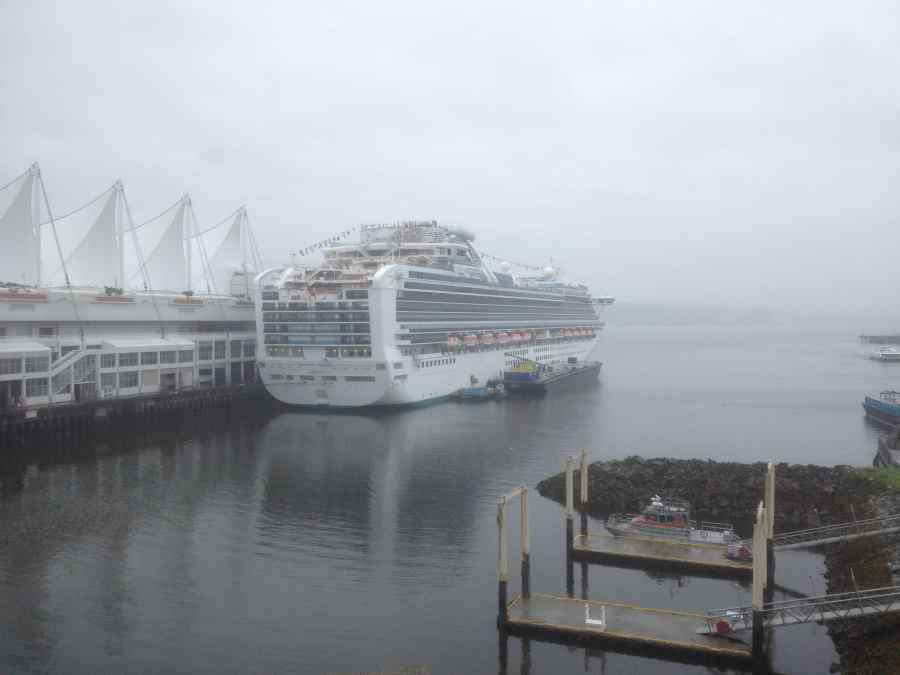
5. Embarkation and Disembarkation Processes
The embarkation process of cruise passengers begins upon arrival at the cruise terminal. In home-ports, a number of different spaces and services are provided to facilitate the process:
- Entrance space is a gathering space for passengers arriving at the terminal, a shelter from the weather, a place to seek information, and a place to queue for the next step in the process.
- Bag drop space where bags are brought for the security check and organizing prior to loading onto the ship.
- Luggage security controls (X-ray scanners ) that allow thorough luggage monitoring, and detecting objects that are not allowed to be taken on board.
- Queuing space that includes multiple lanes for passengers to process through security controls boarding the vessel.
- Passenger security controls (passenger X-ray lanes), with operating schedules adapted to the size of traffic, peak hours, and other local and cruise-ship requirements.
- Ticketing where passengers pick up their tickets before check-in if not available through prior arrangements.
- Ticket area queue where passengers queue before checking in so that people can move quickly from ticketing to boarding.
- Check-in area with counters where cruise-line staff process passengers for the designated cruise trip. The use of new technologies like mobile applications or bar-coded wristbands in the check-in process is already bringing changes in the layout of this area.
- Waiting areas for checked-in ticketed passengers to wait until boarding can begin. This space is large enough to allow for ample seating and circulation area, as well as space for cruise information and other pre-travel material the cruise lines have.
- Boarding corridors where passengers move toward the vessel.
- Staff offices for cruise operator staff, cruise line staff, and port security.
- Other spaces, such as spaces where passengers can have their pictures taken, VIP lounges separated from the general embarkation experience, and even wedding and other special group spaces.
The size and location orientation of each of the above spaces and respective services varies from one cruise terminal to the other. Not all of the spaces listed will be found in every terminal or found in similar arrangements. Security might take place at the entrance of the terminal building or after check-in. Well-developed VIP spaces do not exist in all terminals, as the configuration is determined to meet the needs of all stakeholders (port, cruise lines, operator, customs, and port security). In any case, the terminal needs to offer a positive experience to passengers , as it might provide the first impression to the embarking passengers and it is thus valued significantly by cruise lines. Further, if the terminal is too small for the capacity of the cruise ship, discomfort can result from passengers being forced to stand up in crowded spaces over periods of time.
The disembarkation process in the home port begins before a passenger leaves the vessel to enter the terminal, aiming at reducing the processing time to a minimum and maximizing this final experience for the passenger. The different spaces and services that are provided in home-port terminals include:
- Boarding corridors for disembarking passengers.
- Customs, immigration, quarantine, and police spaces and processes.
- Baggage lay down , which is often the single largest space in the building. Luggage is brought directly from the ship according to deck level and grouped via a “lay-down” process that takes place before passengers enter the space. While in most cases separation refers to baggage waiting in different spaces per group of passengers, more sophisticated processes of managing bags also exist, the most obvious being carousels such as those used in airports.
- Customs areas for passengers to proceed after luggage collections to processing counters, and to conclude applicable procedures.
- Meeting spaces where passengers gather and meet with others and move to ground transportation.
In ports of call, the disembarkation/embarkation processes are less complex, particularly since passengers do not carry luggage. The terminals do not usually have or need a building to host passengers since the (dis)embarkation time is normally short, lasting less than an hour, with access to the local means of transportation or to the walkways and back to the ship having to be as fast and simple as possible. In the absence of a terminal building, the port provides an open space along the quay to enable passengers to gather comfortably. If a terminal building exists, transit terminals do not require spaces for the check-in process or luggage operations.
6. Ground Transportation
The ground transportation area of a cruise terminal is where passengers arrive from all transport modes to embark on the cruise. It is also where they disembark to take any transportation mode to travel inland, usually through public roads and transit systems. Since the passengers of a single cruise generate large numbers of inland trips , ground transportation is an important function of the cruise terminal. As traffic needs to move quickly, safely, and efficiently from and to the terminal and from and to the city, this area must be located close to the terminal building. The ground transportation area includes spaces for:
- Coach parking , such as shuttle buses provided by the port or the cruise lines and tour buses provided by the ship and independent excursion buses.
- Taxi lines with comfortable space around the cars to facilitate loading and unloading.
- Drop-off spaces such as a short-stay car park earmarked for people dropping off or picking up passengers.
- Parking spaces for passengers who drove to the terminal to take a cruise.
- Regional and local connectivity to both the local and regional intermodal system, such as the airport, needs to be connected to the home port by rail or road.
The modal distribution of cruise passenger mobility differs by port. Passengers can decide to take a coach, a taxi, a private car, or go on foot depending on factors such as proximity to major hotels and connectivity to the regional transport system. Space assigned to ground transportation services at a cruise terminal depends on:
- Type of cruise vessel operations at the port of call, with buses and shuttles being the main transport mode. In a home-port taxis and private transport are the most used transport mode, together with transfers and connections with the airport.
- Port-city distance where the cruise terminal is within a metropolitan district, most of the passengers might go into the city by foot, depending on the presence of pedestrian corridors. However, if the city is far off a shuttle system transport is provided.
- Transport systems available as several transport modes and services near the terminal area, such as car parks, train connections, and airport connectivity, are considered.
- Other factors such as local, regional, and environmental considerations may affect the design criteria. A terminal in an area of recurrent high temperatures may need to provide air conditioning in most ground transportation areas. In contrast, a terminal in an area prone to security risks will need to ensure that these areas are secured.

In addition to infrastructures such as quays construction, dock expansion, dredging of channels and basins, waiting areas, and gangways that improve traffic flows and accessibility, modern cruise terminals also involve shoreside projects . In many cases, land reclamation, retail, restaurants, and hotels are of equal importance. The multi-purpose use of cruise terminals is of a different type. Due to their service and touristic orientation, the terminals are ‘people-friendly’, rather than ‘cargo friendly’. Thus, they might be used with open access to the public for events or other usages. This is especially the case as the seasonality of cruise activities implies that several terminals host cruise ship calls for only a few months each year.
Beyond the change in the usage of existing infrastructure or the development of greenfield projects, recent developments have also revolved around the adaptive reuse of brownfield assets . Such cases can be found in the United States, both at the East (Brooklyn and Galveston) and the West (San Francisco and San Diego) coasts. In all cases, cruise port infrastructure development takes far longer than building new cruise ships, meaning that ports may lag behind in trying to meet vessel capacity developments in the market.
Related Topics
- Chapter 3.1 Terminals and Terminal Operators
- Chapter 3.2 Terminal Concessions and Land Leases
- Chapter 5.4 Port Pricing
- Chapter 8.1 Cruise Ports
- Cheng, Z. Gong L. and Li C. (2020). Design and Practice of Cruise Ports. Singapore: Springer .
- Pallis, A. A. 2015. “Cruise shipping and urban development state of the art of the industry and cruise ports”. OECD-ITF Discussion Paper 2015-14 , OECD: Paris.
- PIANC Working Group 152 (2016). Guidelines for Cruise Terminals. Brussels: PIANC.
Share this:
A Sinuous Cruise Ship Terminal by RUR Architecture Redefines Taiwan's Waterfront

Kaohsiung Port Terminal serves Kaohsiung Harbor, the busiest port in Taiwan. Photo © Iwan Baan
Architects & Firms
Resembling a pod of porpoises frozen in midleap, the Kaohsiung Port Terminal gradually rises into view above a mundane skyline as one approaches from the southern Taiwanese city’s downtown. At the waterfront—a patchwork of parking lots and construction sites, shipping containers and cranes—it’s difficult to tell whether the building is emerging from the sea or from the land. Passing the light-rail stop at street level, one ascends to the automobile drop-off at the main entrance, set on a raised platform that extends almost to the site’s perimeter. Only here does it become clear that the architecture is not a set of discrete overlapping and intertwining objects, like a school of fish or a den of snakes, but rather a single multilimbed (or multiheaded?) creature, its asymmetrical tentacles and snouts all sprouting from the arrival lobby.
This international cruise ship terminal is the second major project in Taiwan by RUR Architecture, the New York–based practice of husband-and-wife team Jesse Reiser and Nanako Umemoto. Incorporating a tower containing administrative offices for Taiwan’s busiest port, the terminal is described as “three-dimensional urbanism” by its architects, who hope this initial node will guide and connect future development along the waterfront. Wrapping around the exterior, the entry platform doubles as a boardwalk with an expansive view of the harbor, as well as a broad canopy for informal street markets. Various elbows and groins contain gardens in arrays of dots and stripes. From certain angles, it all feels somewhat predatory and surreal. Are these vermiform extrusions looming overhead to be understood as blind, snuffling trunks in search of airborne prey? Or, more benignly, a consequence of tropism, the botanical phenomenon that causes plants to twist or grow toward sunlight, nutrients, and moisture?
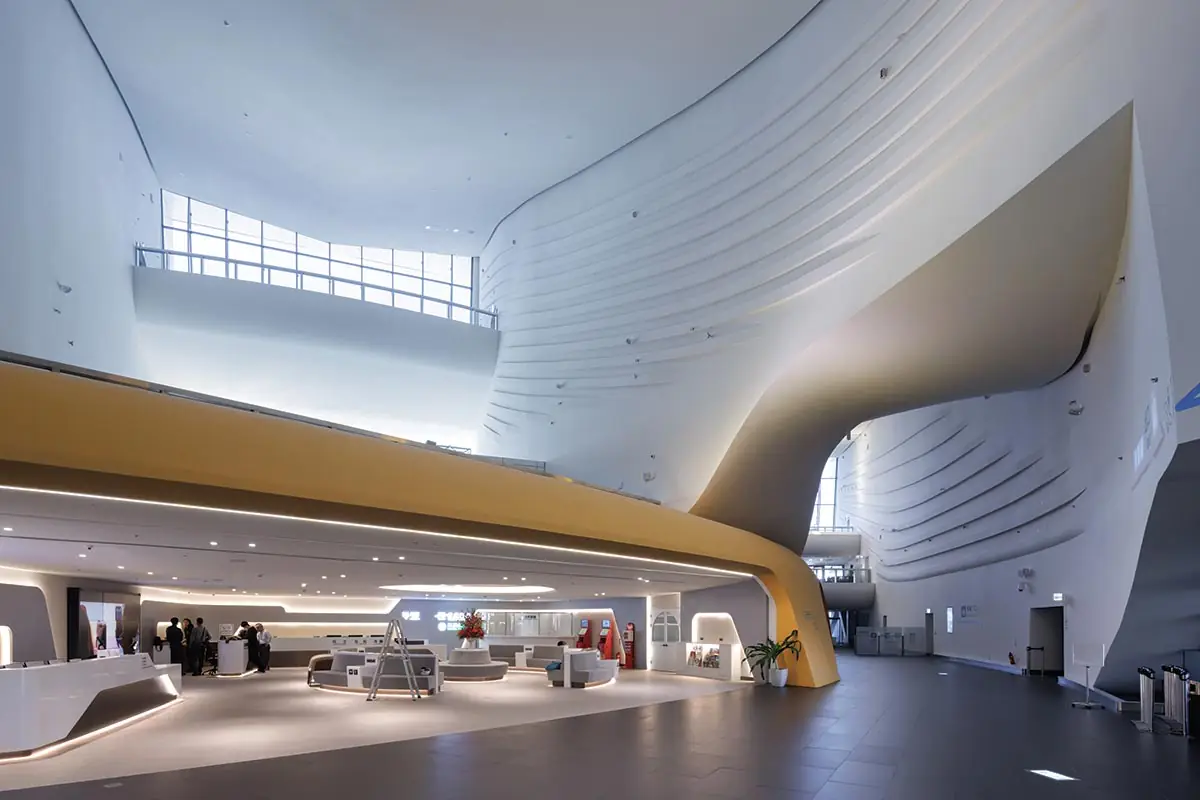
Smooth surfaces line interiors (1 & 2). Photos © Iwan Baan, click to enlarge.
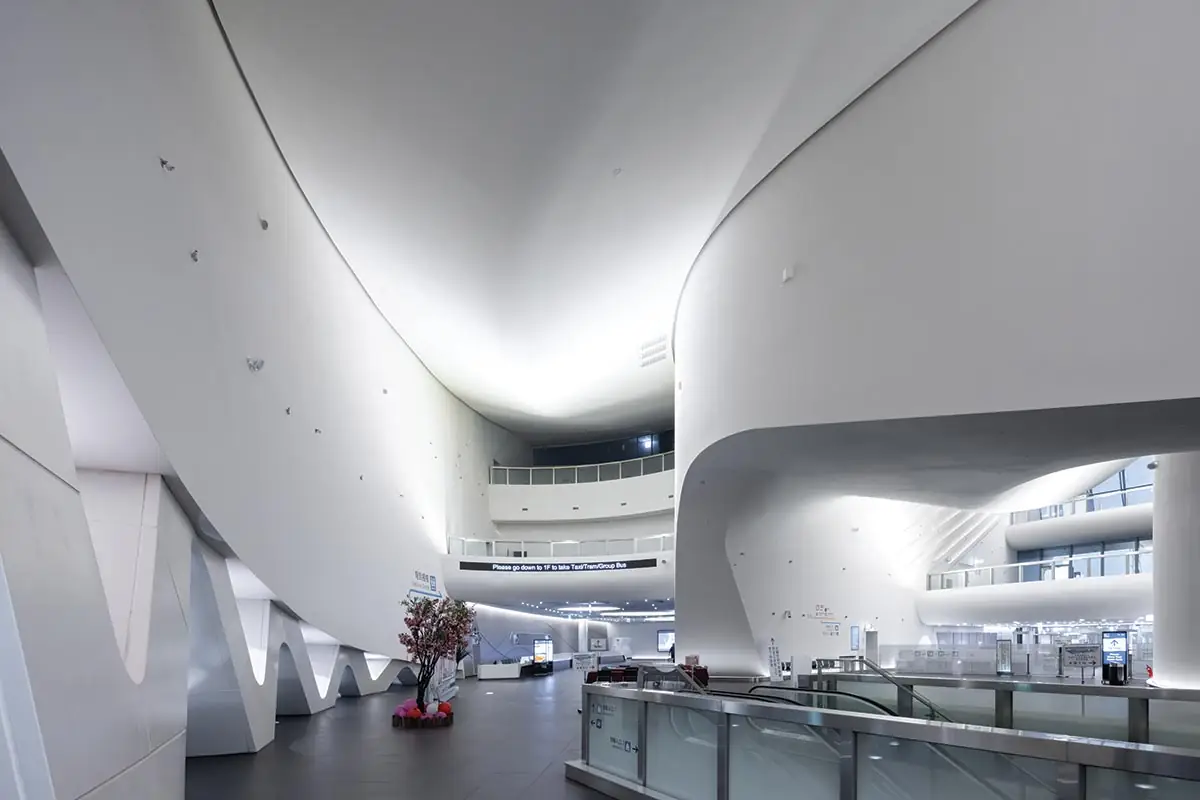
While this talk of biology may sound overwrought, it is in many ways relevant—not only to the terminal but also to the architects’ design process more generally. An extraordinary achievement in terms of form, space, structure, and material, the building is an efflorescence of ideas and techniques explored by Reiser and Umemoto over the course of their careers. They admit that the interest in zoomorphism partly originates in their exposure, as students at the Cooper Union in New York, to the figural experiments of longtime dean John Hejduk, in which Reiser detected “a feeling of empathy between building and people, much like the Japanese belief in the latent animism of things that charges objects with a certain vitality.” But the direct precursors in their own work are the trilobed schemes for the Cardiff Bay Opera House competition in 1994 and the Taipei Music Center . At Kaohsiung, the directionality is reversed; rather than three auditoriums oriented toward a shared stage, as in Cardiff, or three buildings organized around a plaza, as in Taipei, here the spaces expand outward and upward from the central lobby.
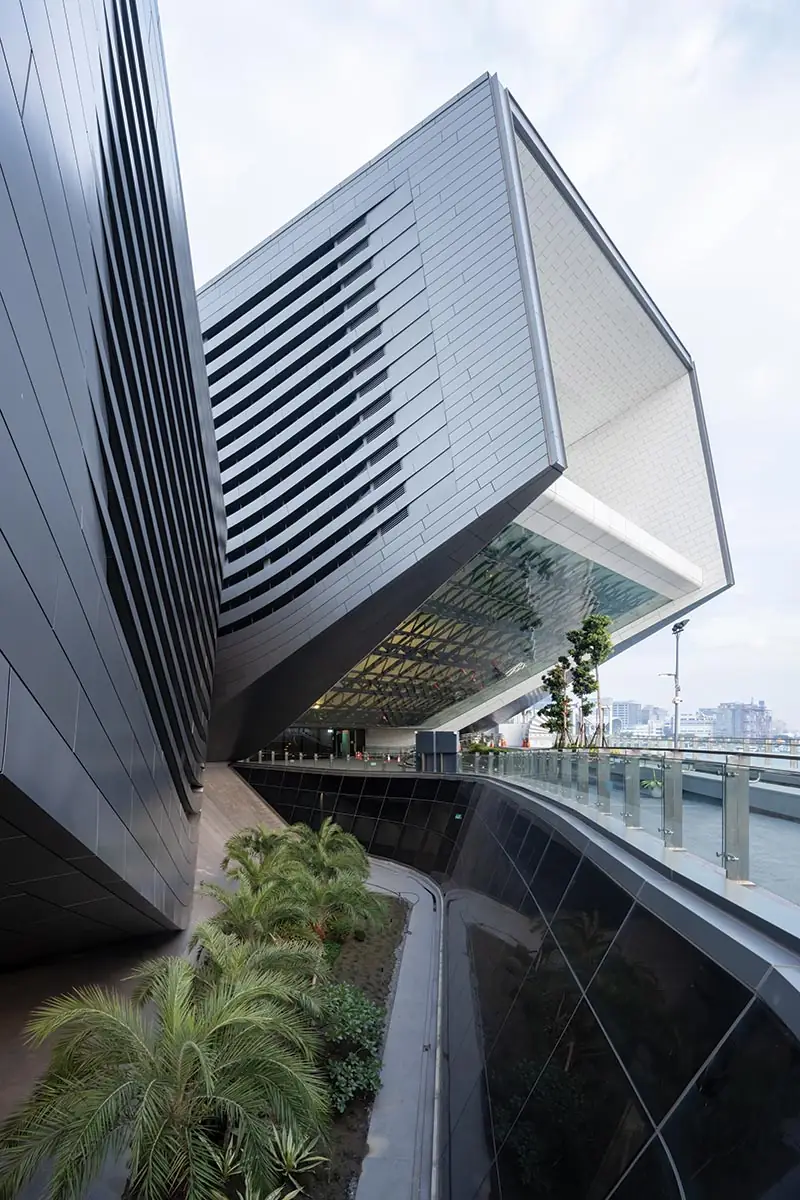
Rearing cantilevers cover entrances. Photo © Iwan Baan
With fully transparent ends oriented toward the sky, and partly glazed throats allowing views down to the esplanade and the water beyond, the rearing cantilevers are a combination of steel trusses and spaceframes—effectively enormous box girders that more or less smoothly merge with the canted office tower and its diagrid exoskeleton. The aluminum envelope, with gill-like slats and scalelike panels, at first appears to be a thin skin. In fact, it has a varying thickness that conceals not only structural and mechanical elements, but a network of secondary public corridors. This intricate spatial manifold is, according to the architects, inspired by the engines of Ferrari’s Formula One cars, but again reflects Hejduk’s influence—specifically his pedagogical exercise of transforming a musical instrument into a building. The terminal recalls the combination of functional and aesthetic precision that produces both the elegance of a clarinet and the awkwardness of a set of bagpipes. Such biomechanical analogies might suggest that the terminal was parametrically designed, using calculus-based, continuously varying forms. Actually, the sinuous profiles are concatenations of elliptical segments connected at tangent points, painstakingly crafted through hand drawings and models, then later finessed with software.
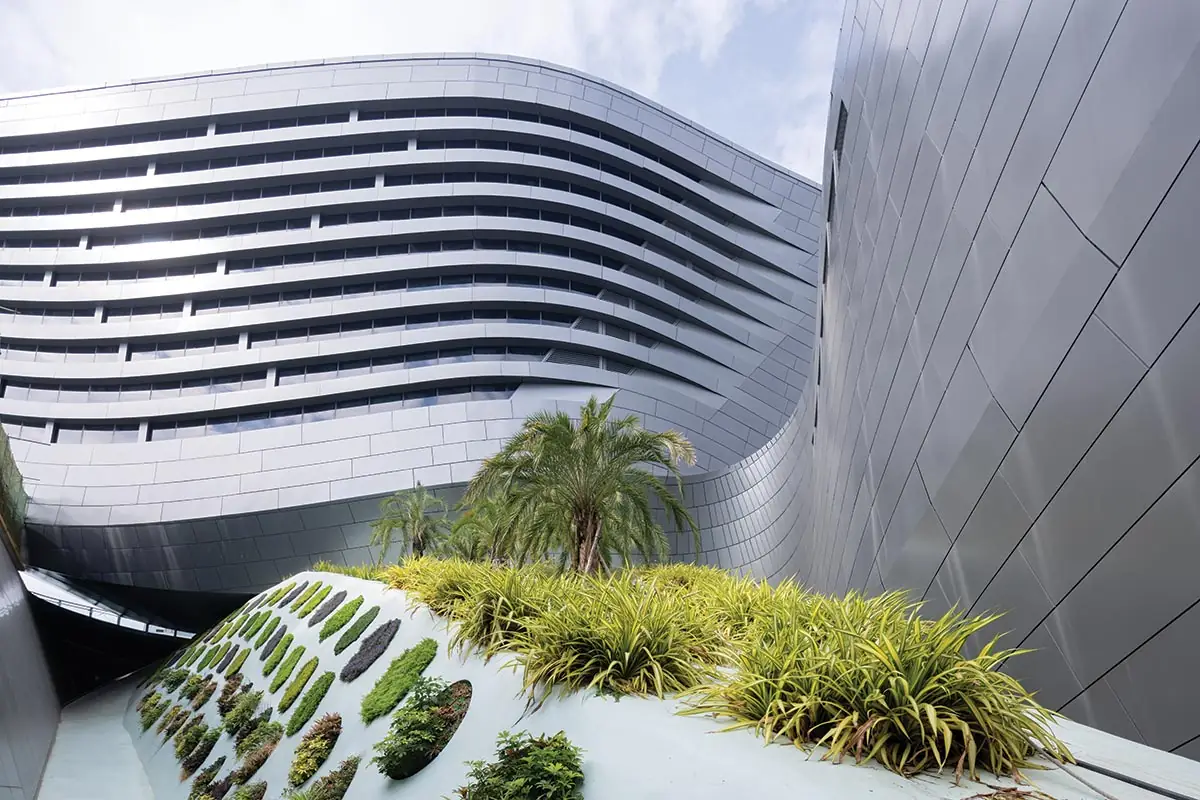
Gill-like openings in the cladding (3) bring light into the terminal, which includes an integrated office tower (4). Photos © Iwan Baan
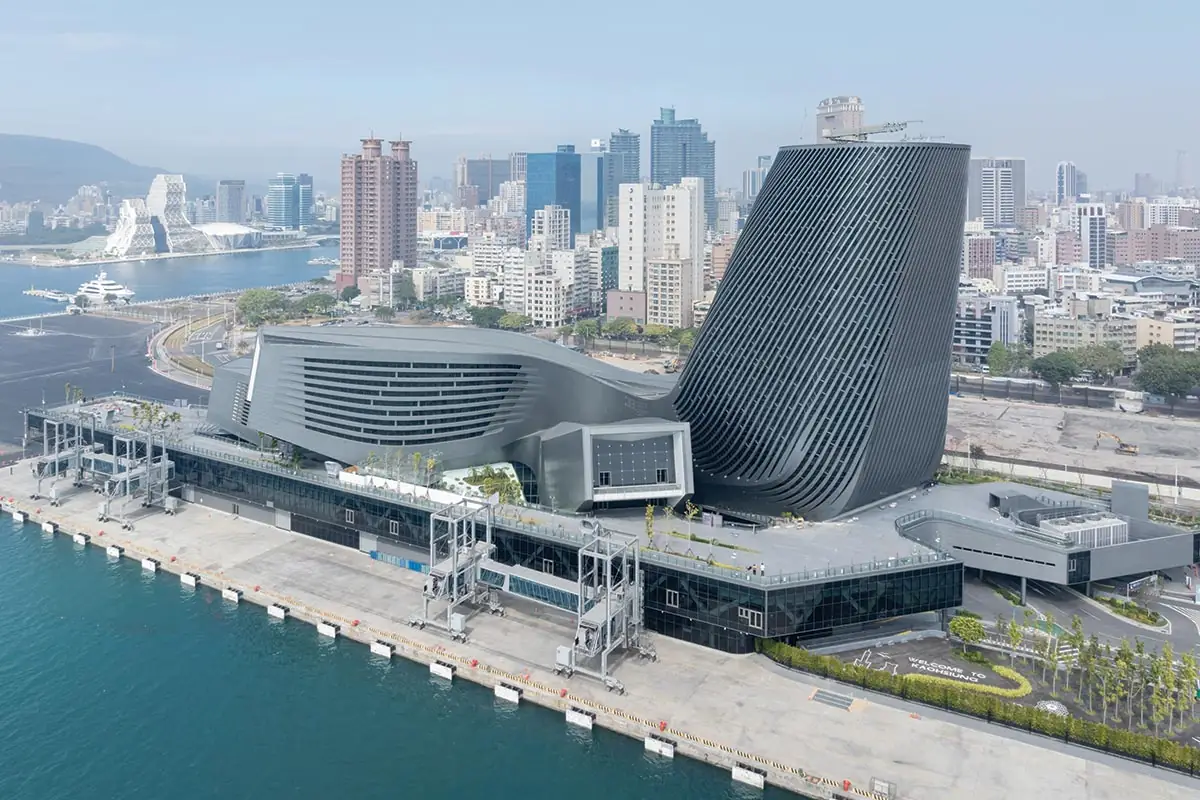
Not everything has gone according to plan, of course. The legal requirements of privacy, security, and fire safety for an international transport facility have necessitated physical and visual barriers—ranging from guide ropes and glazed partitions to solid bulkheads—in places where the architects had hoped for continuity. In some cases, these have been grudgingly integrated with the body of the architecture; in others, they were installed retroactively. Navigating the cavernous interior might be a confusing experience for tired tourists expecting a clearly demarcated sequence of ticketing, immigration, customs, and boarding areas, but it is never difficult and, above all, never dull.
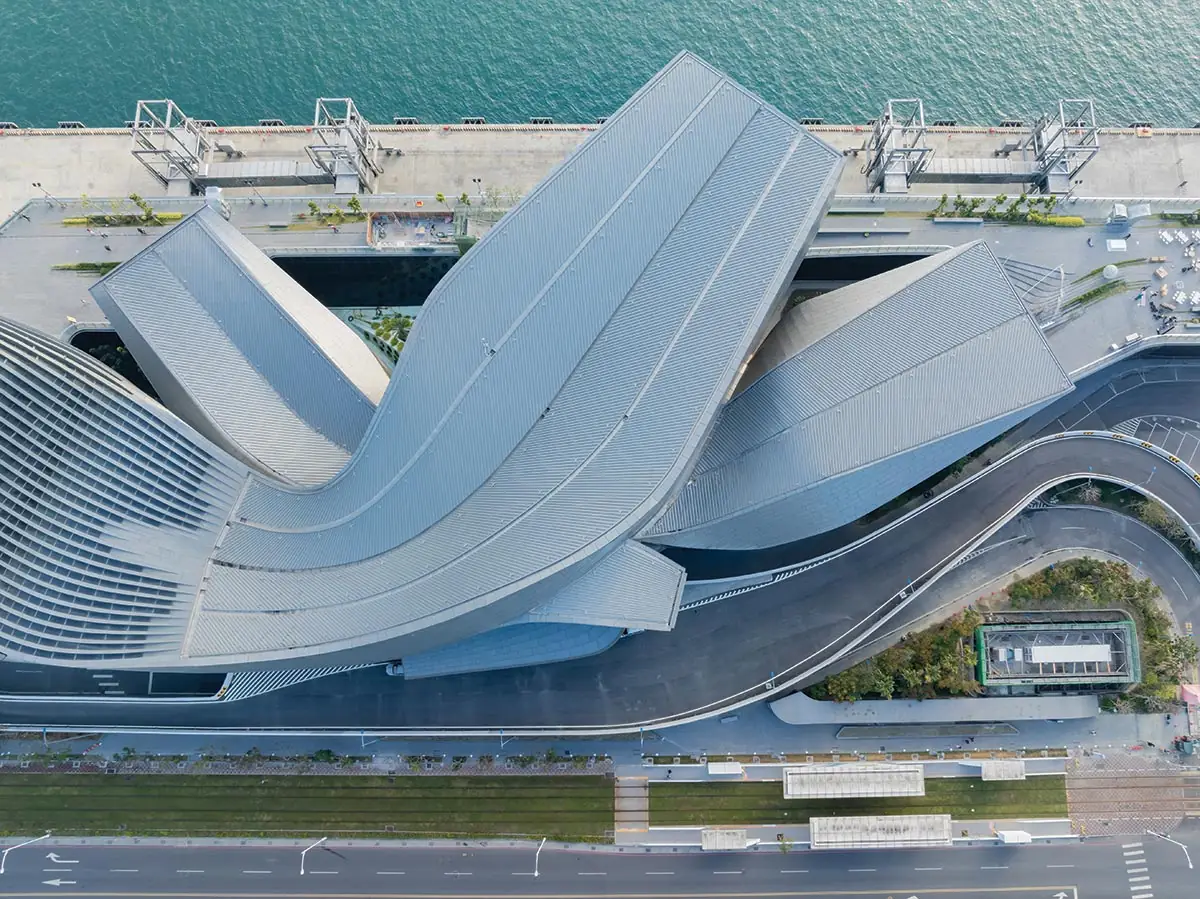
Entry and exit ramps for automobiles echo the curvilinear nature of the terminal’s many limbs. Photo © Iwan Baan
Though the building was unshaken by the April earthquake in Taiwan’s Hualien County, 125 miles to the northeast, when leaving by sea or by land, one might catch a glimpse of movement in the rearview mirror. The parallax effect seen from a turning or receding vehicle causes a slow, majestic shifting of the silhouette of the Kaohsiung Port Terminal as it seems to come to life.
Click plan to enlarge
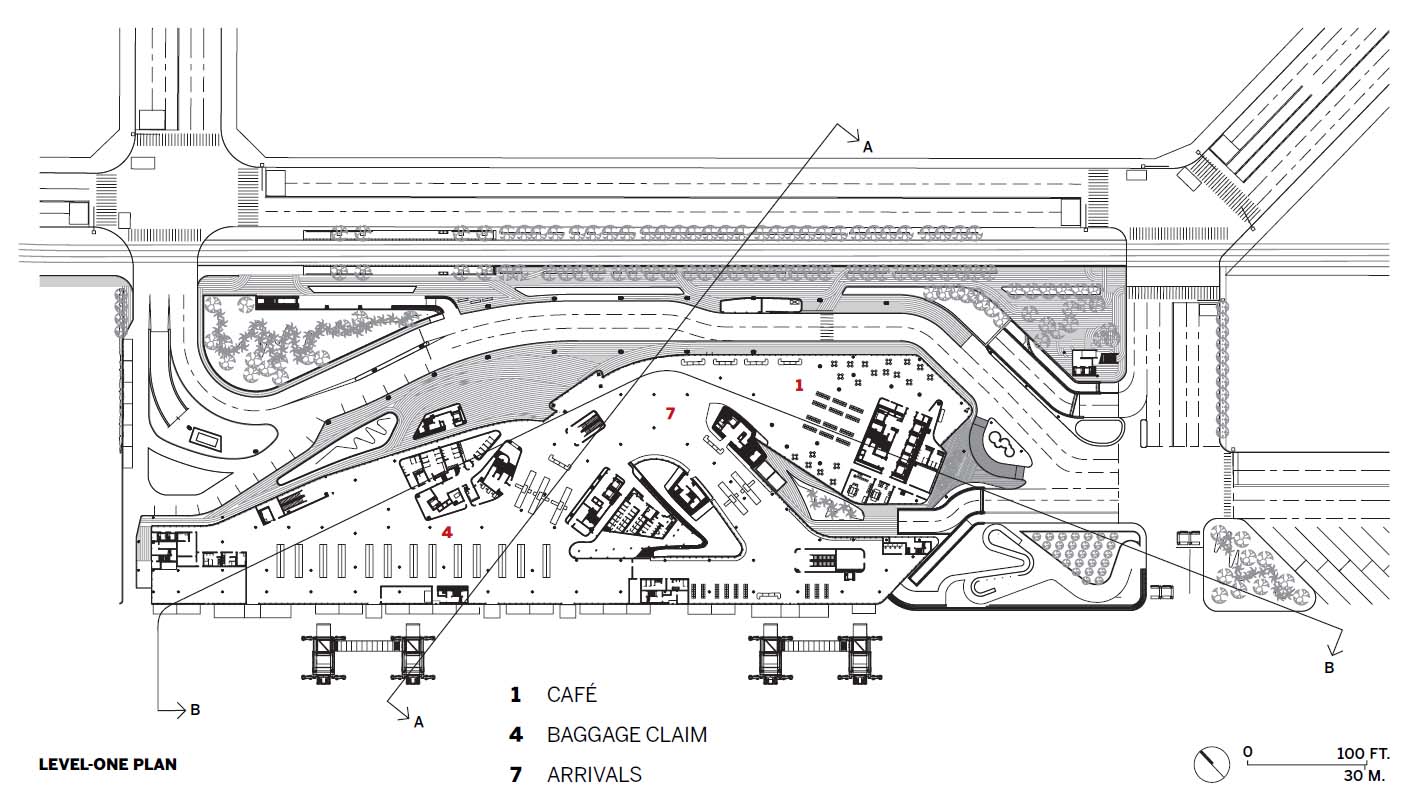
Click section to enlarge
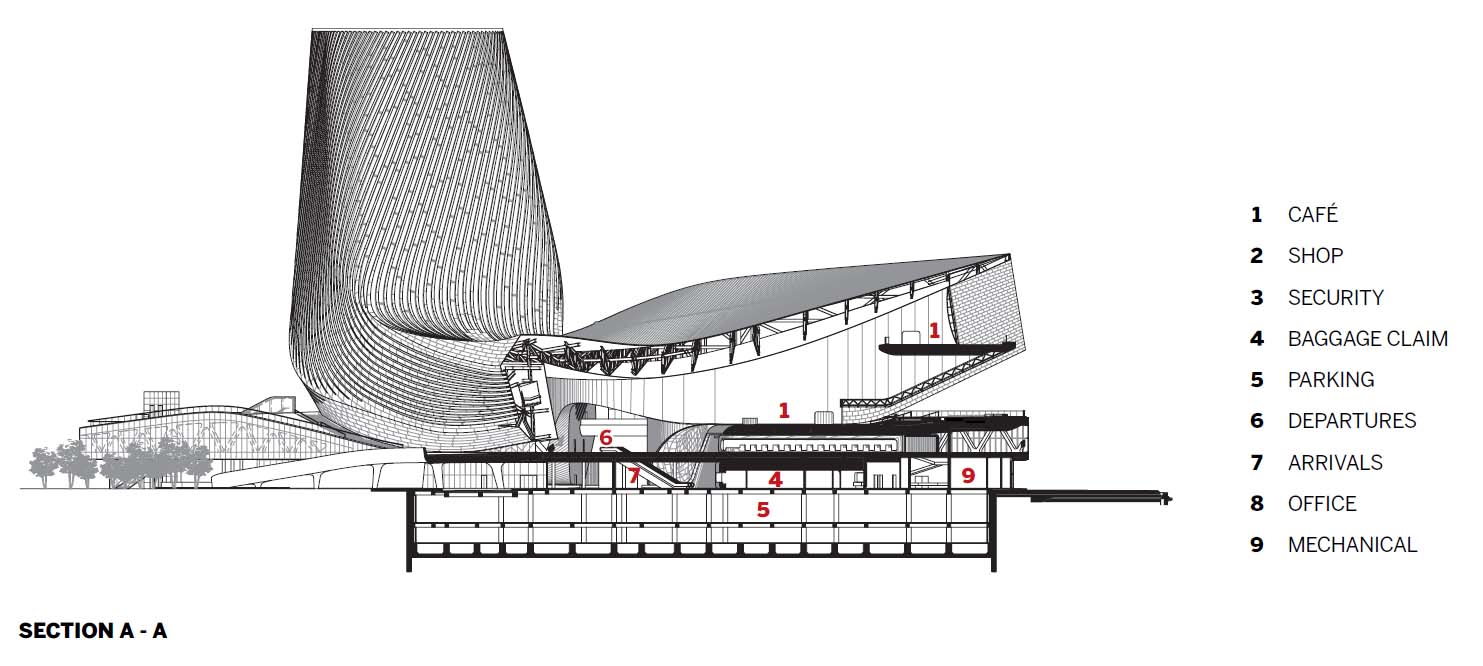
Architect: RUR Architecture — Jesse Reiser, Nanako Umemoto, principals; Jasmine Lee, Neil Cook, Michael Overby, Kris Hedges, Eleftheria Xanthouli, Juan DeMarco, Massimiliano Orzi, design team; Toshiki Hirano, Sonya Chao, Imaeda Ryosuke, assistants
Architect of Record: Fei & Cheng Associates
Engineers: Ysrael A. Seinuk, Supertek (structural); Arup, I.S. Leng, Mininger (m/e/p)
Consultants: Arup (port planning and logistics); Environmental Arts Design (landscape); Meinhardt Facade Technology (facade); Izumi Okayasu Lighting Design Office, Fomolux (lighting)
General Contractor: Chun Yuan Construction
Client: Kaohsiung Harbor Bureau
Size: 397,000 square feet
Cost: $165 million (construction)
Completion Date: March 2023
Share This Story

Post a comment to this article
Report abusive comment.
Restricted Content
You must have JavaScript enabled to enjoy a limited number of articles over the next 30 days.
Related Articles
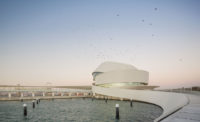
Porto Cruise Terminal
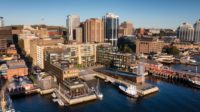
MacKay-Lyons Sweetapple Architects Make Their Mark on Halifax's Waterfront
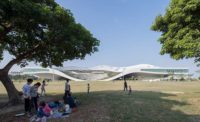
Mecanoo’s Weiwuying National Center for the Arts Opens in Taiwan
The latest news and information, #1 source for architectural design, news and products.
Copyright ©2024. All Rights Reserved BNP Media.
Design, CMS, Hosting & Web Development :: ePublishing
Guidelines for Cruise Terminals
This report has been drafted by an international working group (WG 152) set up by PIANC in 2012. The objective of the work was to provide a guideline for the functional design of cruise terminals, by reviewing the current state of the art of the needs of modern cruise ships and evaluating the ship/port interface and the port facilities involved in cruise traffic. This document embodies a flexible design approach so that terminals can be adapted to the various current and future needs of cruise companies.
rnrnPIANC Working Group 152 has prepared this document to provide technical guidelines for assisting the development of cruise port facilities. Based on the newest trends in cruise ships and the industry in general, the document covers all areas involved in the operation of a cruise ship: waterside drivers, apron area, terminal building and ground transportation area. In view of the importance to the cruise industry of port security and operational and financial aspects, special emphasis has been laid these two topics.
rnrnThe Terms of Reference for WG 152 were laid down by the Maritime Commission of PIANC and can be summarised as follows:rn
Are you sure?
There is already another item in the cart. If you continue, the old item will be removed and replaced by the new one.
Are you sure you want to continue?

MAD architects wins competition to design an international cruise terminal in chongqing
Chongqing cuntan international cruise centre.
MAD architects took inspiration from orange gantry cranes to design the winning scheme for a 65,000 sqm international cruise terminal in chongqing, china . the project, led by ma yansong, and in collaboration with the china academy of building research (CASR), will transform an existing cargo terminal in the city’s cuntan port area with access to the yangtze river. the new program comprises a 15,000 sqm cruise port and 50,000 sqm of commercial space.
‘chongqing has mountains and waters,’ said ma yansong, reflecting on the vision behind the winning scheme. ‘however, the yangtze river is more than just a natural landscape in chongqing. because of human activities such as shipping traffic and industrial transport, this mountain city is also full of energy and movement. we want to transform this energy in chongqing from traces of industry into an energy that stimulates the imagination. people can feel the kinetic energy of the city here, but also imagine the public spaces of the future.’
six science fiction-like buildings inspired by past industry
the above-ground part of MAD’s proposal—called ‘yangtze river skywalk’—is composed of six elevated buildings of varying heights that are interconnected along 430 meters. the color and form of these towers are informed by the large orange gantry cranes that dominate the freight terminal, which the design team noticed while visiting the port site.
‘these gantry cranes became living alien creatures that gave a sense of surrealism,’ ma noted. ‘the new scheme is therefore not only about reflecting the industrial colors of the past, but also about respecting this original surrealism. we have designed the elevated buildings as if they were a futuristic, free-walking city, seemingly arriving here from elsewhere, and perhaps traveling elsewhere once again someday.’
the elevated buildings will be clad in an aluminum curtain walling with floor-to-ceiling glass offering unobstructed views of yangtze river. these spaces will host mixed-use tenants, including shops and restaurants.
the cruise ship landscape park and cruise centre hub
below the six elevated buildings will be the new cruise ship landscape park, which will connect to the century cuntan park on one side and the pier park on the other to create one 100,000 sqm urban green space. from here, visitors will be able to enjoy a unique perspective of chongqing and the yangtze.
underneath the new park is the cruise centre hub, providing access to the ‘floating’ complex and the ground-level landscape park. the design of the cruise centre includes skylights to enhance natural light within the interior space, while an upper cantilevered building avoids overbearing direct sunlight.
MAD architect’s competition-winning scheme aims to establish a unique urban landmark for chongqing that links with the city’s industrial past. it’s also just one part of a 6 square kilometer masterplan to transform the port area into cuntan international new city—an ‘integrated ship, port, city, tourism, shopping and entertainment’ district and the world’s preeminent river cruise port.
the cuntan international cruise centre is slated to begin construction in november 2022 and be completed by 2027.
project info:
name: chongqing cuntan international cruise centre
type: public transport location: chongqing, china
architecture: MAD architects
principal partners in charge: ma yansong, dang qun, yosuke hayano associate in charge: liu huiying design team: yang xuebing, lei kaiyun, wang ruipeng, chen wei, ning tong, wang yiding
client: chongqing cuntan international cruise home port development co. consortium: china academy of building research ltd.
site area: 66,000 sqm GFA: 65,000 sqm cruise port: 15,000 sqm commercial: 50,000 sqm
year: 2021-2027
architecture in china (1756)
Mad architects (152), product library.
a diverse digital database that acts as a valuable guide in gaining insight and information about a product directly from the manufacturer, and serves as a rich reference point in developing a project or scheme.
- architecture in the philippines (23)
- concrete architecture and design (704)
- residential architecture and interiors (3855)
- architecture in norway (177)
- carbon neutrality? (149)
- snohetta (179)
- where people work (858)
- architecture in the czech republic (137)
- brick architecture (310)
- christian kerez (4)
- architecture on stilts (79)
- fictional architecture (218)
- glass art and design (163)
- shipping container architecture (196)
designboom will always be there for you

Guidelines for Cruise Terminal Design and Operations
- March 19, 2016
Guidelines for cruise terminals and related infrastructure have been published by the World Association for Waterborne Transport Infrastructure (PIANC).
Set up in 2012, a working group has developed what the PIANC calls a set of guidelines for the functional design of cruise terminals based on a study of the needs of modern cruise ships and port facilities involved in this traffic sector.
According to David Pino, chairman of the working group and head of the planning and technical management of concessions at the Port of Barcelona, the guidelines cover all areas of cruise ship port operations, including the wharf side services areas, the terminal building and land transport areas, in addition to security, operational and financial aspects.
Cruise Industry News Email Alerts
- Breaking News
Get the latest breaking cruise news . Sign up.
54 Ships | 122,002 Berths | $36 Billion | View
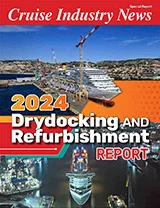
Highlights:
- Mkt. Overview
- Record Year
- Refit Schedule
- PDF Download
- Order Today

- 2033 Industry Outlook
- All Operators
- Easy to Use
- Pre-Order Offer
- Advertising
- Cruise News
- Magazine Articles
- Quarterly Magazine
- Annual Report
- Email Newsletter
- Executive Guide
- Digital Reports
Privacy Overview
- View Record

TRID the TRIS and ITRD database
Design and Practice of Cruise Ports
This book focuses on design technologies and practical engineering applications in connection with cruise ports and terminals. After a brief introduction to cruise ships and global cruise ports, it addresses the location, structure and layout of cruise terminals, the technologies involved, cruise terminal buildings and supporting facilities. The book also explores practical engineering cases, including projects that the authors have worked on, such as the Shenzhen Prince Bay and Shanghai Wusongkou International Cruise Terminal projects. Systematically discussing the design and engineering aspects of domestic and international cruise terminals, the book offers a practical reference guide for engineers, researchers, practitioners and policymakers in relevant fields.
- Record URL: https://doi.org/10.1007/978-981-15-5428-5
- Find a library where document is available. Order URL: http://worldcat.org/isbn/9789811554278
- © 2020 Zekun Cheng et al., under exclusive license to Springer Nature Singapore Pte Ltd. List of Translators: Li Huijuan, CCCC Third Harbor Consultants Co., Ltd. Yao Jianxin, CCCC Third Harbor Consultants Co., Ltd. Qiu Zhaoshan, CCCC Third Harbor Consultants Co., Ltd. Yu Zheng, CCCC Third Harbor Consultants Co., Ltd.
Springer Singapore
- Cheng, Zekun

- Publication Date: 2020-5
- Media Type: Web
- Features: Illustrations; References;
- Pagination: 321p
- Springer Series on Naval Architecture, Marine Engineering, Shipbuilding and Shipping
- Publisher: Springer Cham
- ISSN: 2194-8445
- Serial URL: https://www.springer.com/series/10523
Subject/Index Terms
- TRT Terms: Construction projects ; Cruise ships ; Marine engineering ; Port operations ; Ports ; Structural design
- Subject Areas: Construction; Design; Marine Transportation; Operations and Traffic Management; Terminals and Facilities;
Filing Info
- Accession Number: 01853547
- Record Type: Publication
- ISBN: 9789811554278
- Files: TRIS
- Created Date: Jul 29 2022 4:56PM
General Layout of Cruise Terminals
- First Online: 27 May 2020
Cite this chapter

- Zekun Cheng 5 ,
- Lei Gong 6 &
- Chen Li ORCID: orcid.org/0000-0002-3421-1426 5 , 7
Part of the book series: Springer Series on Naval Architecture, Marine Engineering, Shipbuilding and Shipping ((NAMESS,volume 4))
430 Accesses
The general layout of cruise terminals is mainly based on the port planning, cruise terminal function requirements, to reasonably arrange the functional layout and water and land space resources, and determine the size and location of each facility.
This is a preview of subscription content, log in via an institution to check access.
Access this chapter
- Available as EPUB and PDF
- Read on any device
- Instant download
- Own it forever
- Compact, lightweight edition
- Dispatched in 3 to 5 business days
- Free shipping worldwide - see info
- Durable hardcover edition
Tax calculation will be finalised at checkout
Purchases are for personal use only
Institutional subscriptions
Quoted from Planning and Design of Cruise Ship Homeport .
Quoted from Design Code of General Layout for Sea Ports.
Quoted from Guidelines for Cruise Terminals, PIANC Secrétariat Général Maritime Navigation Commission, 2016 .
Quoted from Analysis of Safety and Practical Pilotage Operation in Inland River for Large Cruise Ships .
Quoted from Comprehensive evaluation of China’s cruise terminal based on DEA model .
Quoted from Simulation and verification of passenger ship emergency evacuation under emergency .
Author information
Authors and affiliations.
CCCC Third Harbor Consultants Co., Ltd., Shanghai, China
Zekun Cheng & Chen Li
Merchants Shekou Industrial Zone Co., Ltd., Shenzhen, China
College of Transport and Communications, Shanghai Maritime University, Shanghai, China
You can also search for this author in PubMed Google Scholar
Corresponding author
Correspondence to Chen Li .
Rights and permissions
Reprints and permissions
Copyright information
© 2020 The Editor(s) (if applicable) and The Author(s), under exclusive license to Springer Nature Singapore Pte Ltd.
About this chapter
Cheng, Z., Gong, L., Li, C. (2020). General Layout of Cruise Terminals. In: Design and Practice of Cruise Ports. Springer Series on Naval Architecture, Marine Engineering, Shipbuilding and Shipping, vol 4. Springer, Singapore. https://doi.org/10.1007/978-981-15-5428-5_5
Download citation
DOI : https://doi.org/10.1007/978-981-15-5428-5_5
Published : 27 May 2020
Publisher Name : Springer, Singapore
Print ISBN : 978-981-15-5427-8
Online ISBN : 978-981-15-5428-5
eBook Packages : Engineering Engineering (R0)
Share this chapter
Anyone you share the following link with will be able to read this content:
Sorry, a shareable link is not currently available for this article.
Provided by the Springer Nature SharedIt content-sharing initiative
- Publish with us
Policies and ethics
- Find a journal
- Track your research
404 Not found
Submitted by Pappal Suneja
Architectural thesis proposal: international cruise terminal at cochin, india, india architecture news - sep 10, 2018 - 21:33 42432 views.
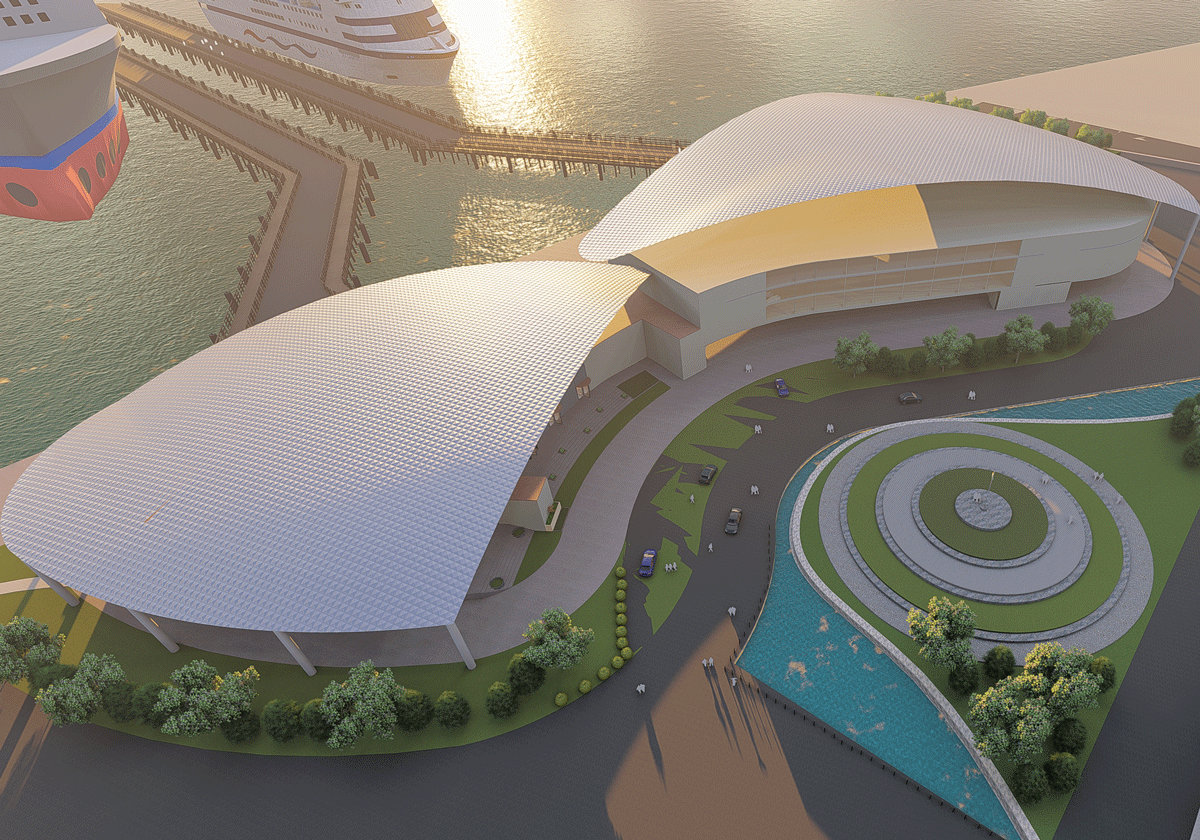
This is Synopsis of Architectural Thesis Proposal submitted to McGAN'S Ooty School of Architecture by Felishia Susan , under the able guidance of architect- Pappal Suneja . On an Introductory note, the Government of India has recognized Cruise Tourism as a potential area to build the economy of the country. It has initiated a number of positive measures to promote the cruise industry in order to position India as a global cruising destination. As a part of its development initiatives, it has identified the 5 major Indian ports of Mumbai, Goa, Cochin, Mangalore, and Chennai to be developed as “world class’’ cruise terminals.
The Proposal - Live Project
In view of this, the Central Government of India has proposed to build a cruise terminal in the scenic port of Cochin (Willingdon Island). Cochin is one of the leading cruising destinations in the country. With its strategic location and proximity to the international waterways, it has the potential to become the most preferred cruising destination globally. The Port Trust of Cochin has thus begun planning a project to build and develop a new 6.7-hectare International Cruise Terminal and public plaza to meet the increasing volume of foreign visitors.
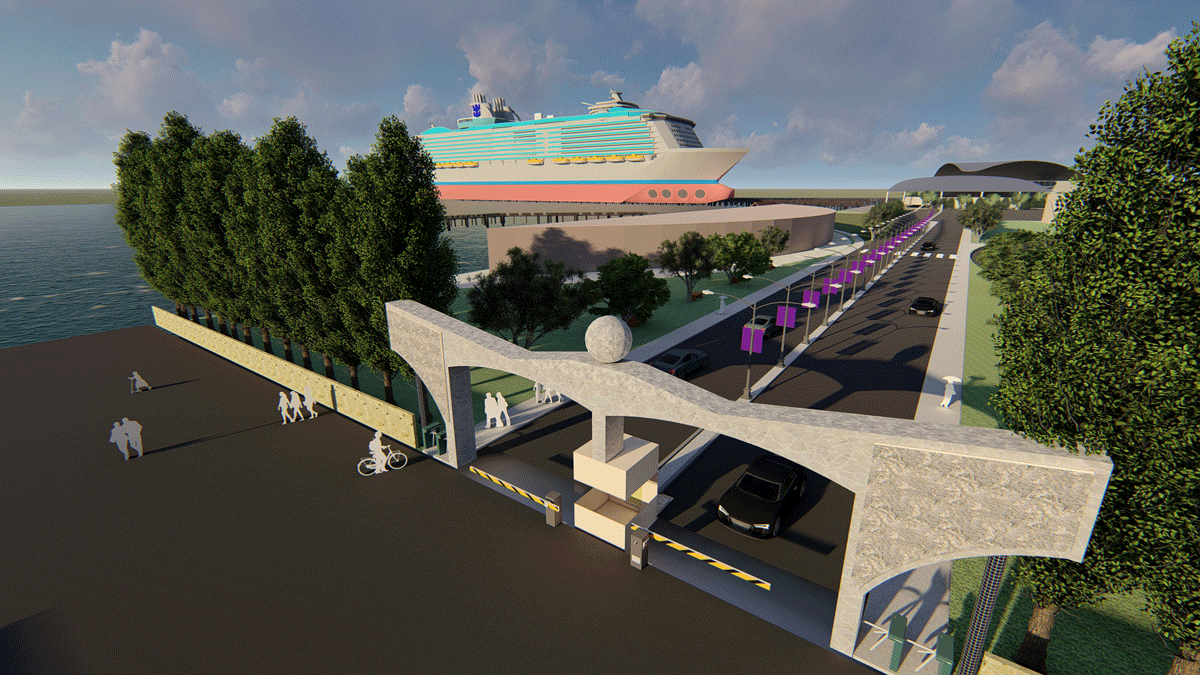
The Mission
This architectural thesis has been specially designed in view of the needs of the above proposal. The aim of the project is to comply with the design requirements of the government’s proposal and deliver an output that would befit the situation. The mission is to attract cruise traffic to the zone through architectural and structural analogies, incorporating climate responsive design strategies and the concept of energy efficient architecture to achieve the highest sustainability.
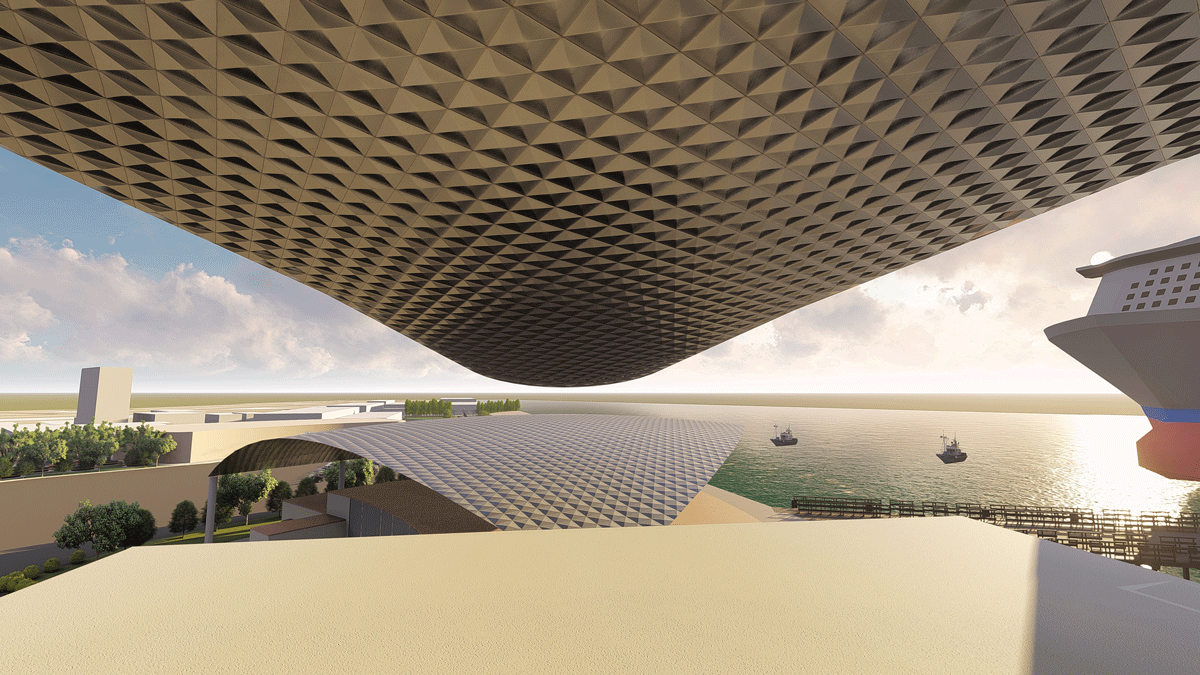
Design Outcome
This unique structure meets the design requirements of functionality, iconicity, accessibility, and sustainability as a single entity. It is a utopian, yet unassuming structure that coherently fits into its surroundings and skyline. The concept and organic design of plan and form are first of its kind in the cruise terminal industry, marking its distinctive character. The utopian design strategy will be a forerunner in the cruise terminal infrastructure development industry of the country in the years to come.
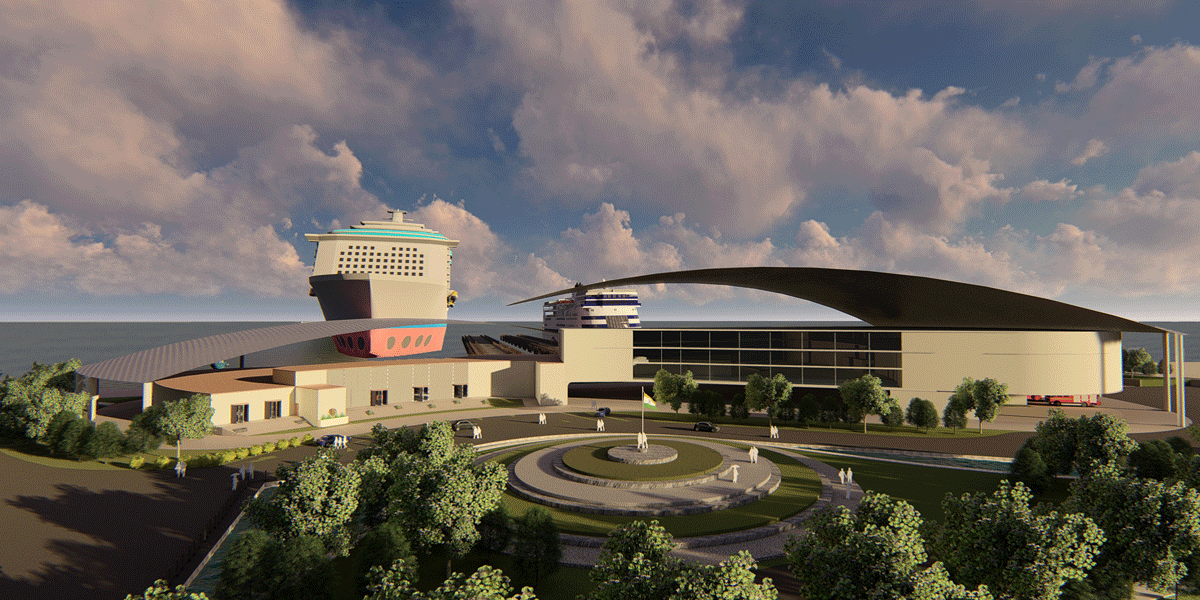
Concept
The architectural design of the structure responds to the functionality and its surroundings. Undulation is a functional concept derived from nature or rather present in nature in many hidden forms such as the rise and fall of sea waves. The formation of waves occurs in nature with the decrease in depth of water level, which is indicative of its relative closeness to the shore. Likely when a traveler, on a cruise, encounters a wave break it is indicative of having reached the shore. This instills in the travelers a sense of “home-coming” .
Hence, the concept of a wave break has been incorporated in form. The form of the building would thus create a sense of homecoming in the tourists and also display its functionality through its form. The wave can easily be associated with the sea and as a traveler on a cruise, approaching the shore, the pleasant sight of the structure would instantaneously reveal that it is a terminal facility. And as for the general public viewing it from ashore, it would create a sense of mysterious marvel and yet reveal that it is a cruise facility, through its abstractive form and its association to the sea.
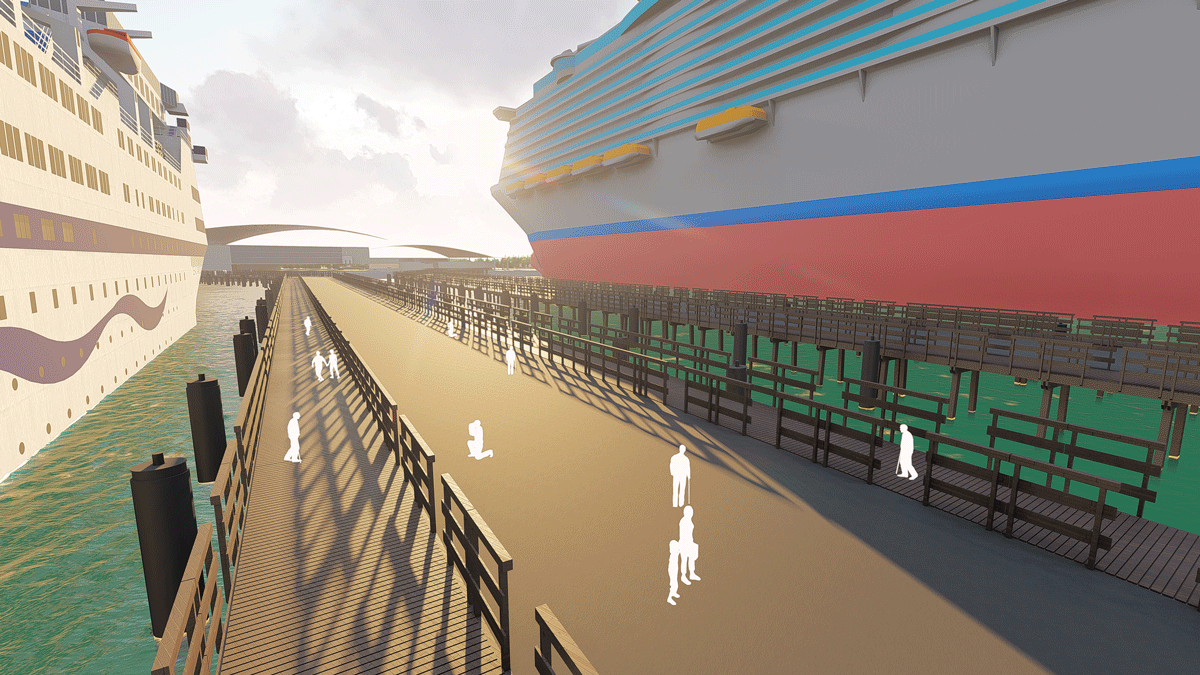
All Images © Felishia Susan
> via McGAN'S Ooty School of Architecture
Other readers also found these interesting...

Guangzhou Nansha International Cruise Terminal Complex by Aedas

The cruise industry is synonymous with luxury leisure. It greatly boosts tourism and thus the global economy (Peručić, 2020). Nansha International Cruise Terminal is a project not only aimed at tourism, but also at creating a vibrant mix of uses across both retail and commercial alongside the operational aspects of the cruise terminal itself. The ambition was to create one of the largest cruise terminals in Asia, which would have a transformative place-making impression on this new district of the city.

Nansha International Cruise Terminal Complex is an immense cruise terminal project in Guangzhou , China . It sits at an estuary of the Pearl River Delta. The terminal sees an annual footfall of up to 7,50,000 passengers. It has a seamless connection with the metro subway, allowing an easy switch between different modes of transport, thus enabling mobility and access to its users. The port boasts of being one of the select few that can dock the world’s largest cruise ship, ‘Allure of the Seas, among others. This large, 23,000sqm project, was completed in 2019 and designed by the internationally renowned architecture group, Aedes.
About the Architects- Aedas
Aedas is a world-renowned architecture firm. It was founded in Hong Kong in 1985. Its current headquarters lie in Beijing , China. Aedas has numerous offices in different parts of the world: New Delhi, Macau, Hongkong, Shenzhen , Chengdu, Shanghai, Beijing, and Singapore in Asia, Dubai and Abu Dhabi in the Middle East, and Seattle in the USA. In addition to their design and architectural practice, Aedas has created a global collegiate platform that uses ideas, research, and knowledge to facilitate idea exchange. This helps share and find urbanization and architectural solutions that are innovative and sustainable.
Aedas’ Design Philosophy
Aedas has high regard for the socio-cultural and environmental norms of the context they design for. Aedas tackles every design with fresh, distinct ideas, rooted in the social and cultural fabric of the community they design for. This makes every project unique. These are then coupled with Aedas’ global team’s expertise to translate contextual inspirations into modern structures. This abstraction of culture into modern interpretation makes their projects rooted, yet contemporary. The Nansha International Cruise Terminal Complex is an explicit example of Aedas’ design approach.

Keeping with their design philosophy, Aedas designed The Nansha International Cruise Terminal Complex using contextual influences to create the modern structure .

Aedas uses whaleboats from a Yuan Dynasty quote as inspiration for the terminal building’s form. It has 6 floors. The massing of the terminal building resembles whaleboats. Its head faces towards another channel and its undulating mass is staggered to appear like fins.
“the terminal building’s design concept borrows from Nansha’s maritime resources with its use of free forms and non-linear outlines, encapsulating the image of whales swimming freely in the open sea.”
-(Nansha International Cruise Terminal Complex / Aedas | ArchDaily, 2022)

The site is located at the birthplace of the primeval “Maritime Silk Road ”. Today, it is a key hub, strategically located at the geographic center of the Guangdong-Hong Kong-Macao Greater Bay Area economic zone and the Belt and Road Initiative.
Aedas uses this as inspiration to create an easy interconnection between modes of transport and maximize access to all users. It is designed to connect with the metro line. Interconnection between the arrivals and departure halls minimizes the walking distance and ensures smooth circulation to support large passenger volumes.
Coastal Community
To engage the local community along the waterfront, locals can also access a scenic promenade from the first-floor commercial street . This effectively minimizes congestion and pedestrian flow. It forms a coastal community that fully capitalizes on Nansha’s nautical culture while honoring its long seafaring history.

The terminal consists of four towers completed in 2022: 3 residential and 1 office building. Aedas has designed each tower with varying numbers of floors and unique elevations. The terminal below forms a horizontal architectural whale boat form that adopts minimalist simplicity to echo the podium design.

Structural + Facade Particulars
Having an expressive and dynamic form and a very large scale, this project required special attention to the execution. Aedas consulted Façade and MEP consultants, Buro Happold, to make this design a reality. One of the distinctive characteristics of the project is the 3D curving surface of the outer layer facade, designed not only for aesthetic beauty – it references the port’s heritage with a shape that suggests a whaling boat – but also for solar shading. It features aluminum cladding and a specialist secondary steel structure (SST).
Experiential Aspects
The project uses cutting-edge technology, culturally derived forms, and public engagement. Alongside these, the Aedas also focuses on the quality of spaces it provides its users with. A full-height atrium creates a spacious atmosphere, providing a relaxed yet vibrant passenger experience. A rooftop garden sits at the top of the terminal building, which can be reached via a viewing elevator where visitors can enjoy panoramic ocean views as well.

Owing to the Aedas’ vision, multifaceted design approach, and the location and vision for the project, the project forms an iconic structure, defining the city’s coastline and celebrating Nansha’s nautical culture while honoring its long seafaring history. It attracts numerous tourists yearly.
Bibliography
Nansha International Cruise Terminal Complex / Aedas | ArchDaily (2022) ArchDaily . Available at: https://www.archdaily.com/985774/nansha-international-cruise-terminal-complex-aedas (Accessed: 21 October 2022).
Peručić, D. (2020) ‘Analysis of the World Cruise Industry’, DIEM : Dubrovnik International Economic Meeting , 5(1), pp. 89–100.

Raveena is passionate about design, architectural theory and the climate crisis alike. She aspires to understand and translate designed space- and its experiential qualities- into buildings that make a difference and respect the earth.

GSK Carbon Neutral Laboratory by Aecom


An architectural review of location: Morena, Madhya Pradesh, India
Related posts.

School for Blind and Visually Impaired Children by SEAlab

Chowmahalla Palace, Hyderabad

Sanskar Kendra, Ahmedabad

Project in-depth: The Channel Tunnel (Eurotunnel), UK-France

The Lingaraja Temple, Odisha

Evergreen Line Stations by Perkins and Will
- Architectural Community
- Architectural Facts
- RTF Architectural Reviews
- Architectural styles
- City and Architecture
- Fun & Architecture
- History of Architecture
- Design Studio Portfolios
- Designing for typologies
- RTF Design Inspiration
- Architecture News
- Career Advice
- Case Studies
- Construction & Materials
- Covid and Architecture
- Interior Design
- Know Your Architects
- Landscape Architecture
- Materials & Construction
- Product Design
- RTF Fresh Perspectives
- Sustainable Architecture
- Top Architects
- Travel and Architecture
- Rethinking The Future Awards 2022
- RTF Awards 2021 | Results
- GADA 2021 | Results
- RTF Awards 2020 | Results
- ACD Awards 2020 | Results
- GADA 2019 | Results
- ACD Awards 2018 | Results
- GADA 2018 | Results
- RTF Awards 2017 | Results
- RTF Sustainability Awards 2017 | Results
- RTF Sustainability Awards 2016 | Results
- RTF Sustainability Awards 2015 | Results
- RTF Awards 2014 | Results
- RTF Architectural Visualization Competition 2020 – Results
- Architectural Photography Competition 2020 – Results
- Designer’s Days of Quarantine Contest – Results
- Urban Sketching Competition May 2020 – Results
- RTF Essay Writing Competition April 2020 – Results
- Architectural Photography Competition 2019 – Finalists
- The Ultimate Thesis Guide
- Introduction to Landscape Architecture
- Perfect Guide to Architecting Your Career
- How to Design Architecture Portfolio
- How to Design Streets
- Introduction to Urban Design
- Introduction to Product Design
- Complete Guide to Dissertation Writing
- Introduction to Skyscraper Design
- Educational
- Hospitality
- Institutional
- Office Buildings
- Public Building
- Residential
- Sports & Recreation
- Temporary Structure
- Commercial Interior Design
- Corporate Interior Design
- Healthcare Interior Design
- Hospitality Interior Design
- Residential Interior Design
- Sustainability
- Transportation
- Urban Design
- Host your Course with RTF
- Architectural Writing Training Programme | WFH
- Editorial Internship | In-office
- Graphic Design Internship
- Research Internship | WFH
- Research Internship | New Delhi
- RTF | About RTF
- Submit Your Story
Looking for Job/ Internship?
Rtf will connect you with right design studios.

- Aluminium Composite Panels
- Inspiration
- News and Event
- Copper Composite Panels
- Zinc Composite Panels
- Zinc Panels
- INSPIRATION
- The Space Story

How ACP Board Design Impacts Visual Merchandising and Retail Environments
Planting promise: aludecor’s csr activity flourishes at adhigam bhoomi, aludecor – india’s first acp manufacturer to attain nabl accreditation for r&d lab.
Deep Dive into Fire Retardant Materials for Modern Architecture
7 Reasons Why Architects are Choosing Zinc Panels for Their Building Projects
Can Zinc Panels be Used for Roofing Applications?
Why should you use Aludecor Zinc Composite Panels?
Aludecor Zinc Composite Panels – A Sustainable Choice for Your Building
What is Brutalist Architecture? An Introduction to the Style
How to Choose the Right Facade Material for Your Building
The Future of Facade Design: 5 Trends to Watch
The Evolution of Architectural Style in Kolkata Since its Origin
Design Trends for the Festive Season 2020
Park Street Carnival: The Untold Story
Space Story Featuring Vardhman Hospital – A Project by Ar. Brij Panjwani
The residency – a statement of luxury, the administration building for plasser india became the “show-stopper” of a virtuoso performance.
Know Why Ar. Amin Nayyar Chose Aludecor ACP Sheets for Kashmir University
ACP Sheet Design for Home Interior: Fusing Form and Function
Ex-Journalist Converts an Old Bus into a Public Toilet for Women Using Aludecor ACP Sheet
Rosé Salon Celebrates Tasteful Flamboyance with Aludecor WabiSabi Metal Composite Panels
Indian War Museum by Collaborative Architecture to be a Part of The Prestigious Display at Cooper Hewitt Smithsonian Museum
‘Back to Work: Rethink, Reevaluate, Retrofit for Safer Workplaces’: A Handbook for Post Lockdown Design Interventions
The ArSHEtect Perspective: Featuring Santha Gour
Mumbai International Cruise Terminal Showcases Ar. Santha Gour’s Eccentric Aesthetics
A rchitect Santha Gour has been working extensively for the past four years as an Architectural Designer and Project Manager for the Mumbai International Cruise Terminal. A very iconic project since its inception, the Mumbai International Cruise Terminal promises to usher in an era of luxury cruise vacations starting from India. A part of the Government of India’s initiative to unlock the untapped potential of India’s beautiful coastlines, the Mumbai International Cruise Terminal asserts the best in class infrastructure and stunning design.
Design Philosophy

Read also: Pinnacle House Celebrates Boundless Design & Timeless Aesthetics with Wabi Sabi

Due to the dual program of the Terminal along with the retail mall, Architect Santha Gour and Team had to pay attention to avoid mixing of passengers of the cruise vessel with a person coming to visit the retail mall in the building. They achieved the same by creating two Vestibules in front of the building that facilitates movement for a person coming to visit the mall. The building provides unhindered and beautiful visuals of the eastern seafront of Mumbai and is an apt location for setting up restaurants, banquets etc.
While designing, Architect Santha Gour and Team also had to keep in mind the traffic movement around the building. The berth that is used for docking of the cruise vessel is also used as docking for cargo vessels on some days. The entire traffic movement is designed in a way that there is never any mixing of traffic and people.
Midway through the project, Architect Santha Gour and Team faced an enormous challenge when they were asked to retrofit the building to take care of the passenger load of another passenger liner. Nevertheless, the same was achieved by also keeping the integrity of the design intact. Other than the Architectural challenges, the most challenging part of the project was the effort that was put in detailing the back end of the building. A lot of attention went into detailing the security and safety aspects of the building.
Read also: Aludecor’s Metallic Shades of ACP Sheets are “As Good as Gold”

The structural design for this building is also very complex as part of the berth is on a slab over the sea, and the other part of it is on reclaimed land. Due to the unavailability of any previous structural drawings, there were quite a few surprises in store for Architect Santha Gour and Team once they started constructing the foundations.
Read also: Ace it with Aludecor’s new 6mm ACP Sheets!
In words of Architect Santha Gour,
There is no project without its share of challenges, or restrictive parameters dominating the design programme. Understanding that as a given and moving ahead to surmount all that comes along, to create something that retains its integrity is Architecture. My learning from this and various other large projects that I am working on currently is that how Architecture design ceases to be a small part of the time invested in a project and how most of the time gets used up in compliances, approvals and documentation. Also, beyond the aesthetics of the building lies a tremendous amount of effort in making the facility run like a well-oiled machine. However, the end result always justifies the effort.
- Architect Santha Gour
- architects in Mumbai
- Architecture
- Infinitti Design Studio
- Metal Composite Panels
- Mumbai International Cruise Terminal
Most Popular
Beyond boundaries: acp louvers in contemporary gate and fence designs, editor picks, popular posts, discover #futurefacades with aludecor’s 3d acp sheet design innovation, some amazing facades that feature innovative facade design strategies, top 5 materials to build your kitchen cabinets with, popular category.
- Aluminium Composite Panels 150
- News and Event 66
- ArchiSpeak 28
- Inspiration 25
- ACP Sheet Design 24
- The Adorner 16
- The Space Story 16
A pioneer in the world of Metal Composite Panels, Aludecor Lamination Private Limited has come a long way since inception in 2004. Aludecor is a premium ACP sheet manufacturer in India. synonymous with trust and reliability. With the promise of quality and innovation, Aludecor stands tall with strong retail network spanning 250 cities nationwide and prestigious clients and satisfied customers all over.
Contact us: [email protected]
© Aludecor. © 2022. All Rights Reserved

Zaha Hadid Architects wins bid for new cruise terminal project
A bid from Zaha Hadid Architects has placed first in the international competition to design the new Riga Ropax Terminal in the Latvian capital. The project will convert an existing warehouse space into a new 20,000-square-meter (215,000-square-foot) terminal for cruise passengers with an added glass and timber fourth level and new triple-height grand hall. ZHA says this will become a new transit hub for Riga, connecting with local tram lines while effectively doubling the capacity of the current port to handle departures and arrivals.

Director Gianluca Racana promises: "Riga Ropax Terminal will be an architectural landmark that serves as a gateway to Riga’s future while respecting its rich history a leading port city. By re-using the site’s existing concrete structures, together with local materials from recycled and renewable sources, the new terminal will be a benchmark in environmentally responsible architecture that incorporates advanced design solutions to reduce energy demand and carbon emissions."

"With vastly improved access to the waterfront and generous amounts of new public space, the project will ensure the areas becomes a popular civic destination for generations to come," Racana added finally.

Latvian practices Sarma Norde Architects and Alps Landscape Architects are providing their assistance for the delivery. ZHA expects work to be completed in time for the end of 2028.
Some current competitions on Bustler that may interest you...

Port Canaveral 's massive cruise operations will be getting even bigger, as port officials announced plans Thursday to build a new cruise terminal at the site of one of its existing north side cargo berths.
Port Canaveral CEO John Murray said the port will convert the current North Cargo Berth 8 area into a cruise terminal and parking garage to help accommodate new cruise ships joining the port's lineup. The new cruise terminal would open in the summer of 2026.
Murray said the port's plan to repurpose the existing cargo berth provides significant savings, flexibility and an expedited construction timeline of about two years. He said this is the fastest way to get a new cruise terminal up and running.
The new terminal will be able to accommodate the largest ships in the world, across a spectrum of brands.
Murray said the new cruise terminal ― if fully utilized by large cruise ships ― could represent $40 million a year in cruise line and cruise parking revenue for the port.
Murray said the port needs to put the north side cruise terminal online quickly so the port does not lose business to another Florida or out-of-state port. That could have happened if the port did not have dock space to accommodate cruise ships on certain days.
"Our six terminals are operating at maximum utilization, in several cases," Murray said.
Murray said the port is still developing cost estimates for the cruise terminal project. He said the construction cost will be paid for out of port revenue from its cruise, cargo and other operations.
South side cruise terminal plan: Port Canaveral has plan to shift marinas to make way for new cruise terminal
The port's announcement will push back — but not eliminate — the port's previously announced plans to build a $175 million south side cruise terminal and parking garage at the current site of Bluepoints Marina . Under those plans, the marina operation would move elsewhere at the port before the cruise terminal opens.
The new south side cruise terminal originally was projected to open in late-2026 or 2027. But Murray said he now is moving that time frame back to 2030 or later, as the port takes more time to plan the redevelopment of its south side Marina District, including to accommodate commercial fishing operations in that area of the port. Plans called for that terminal to be used by multiple cruise lines, and to have a 1,400-foot-long berth space.
Handling 'cruise partner needs'
In discussing plans for the new north side cruise terminal, Murray said: “We have cruise partners with immediate needs to locate assets in Florida, and Port Canaveral is where they want to be. Our ability to efficiently bring a new cruise terminal online was key to retaining and growing this important business segment that supports many jobs and delivers high value to our regional and state economy.”
Murray said the new north side terminal will serve multiple cruise lines, but did not release details on the cruise lines and ships that will use the terminal. He said more information about additional cruise ships basing at Port Canaveral could be announced in the coming weeks.
The timeline for design, engineering and construction of the north side terminal is in development, with the planned opening in the summer of 2026.
Canaveral Port Authority Vice Chair Wayne Justice said the new north side terminal is expected to be smaller than some other terminals the port has built in recent years, thus reducing costs. That's because there is less of a need for large passenger waiting areas, because of the efficient facial-recognition technology that speeds up passenger processing on and off ships.
Canaveral Port Authority Chair Micah Loyd said the new cruise terminal and the business it will deliver "builds on our board’s commitment to the economic prosperity of our port community. This proactive, business-oriented strategy reaffirms our commitment to ensure the state of Florida continues to prosper from cruise tourism and remains the ‘Cruise Capital of the World.’ ”
Port Canaveral is the world's second-busiest cruise port, based on passenger volume, trailing only Miami's port. It had 16 home-ported ships in the winter of 2023-24, and expects to have 19 in the winter of 2024-25, Murray said.
Cruise terminal project details
Murray said Port Canaveral's new north side terminal campus will include a multiple-story parking garage to accommodate up to 3,000 vehicles, initially with more than 2,500 spaces.
The project also will include roadway improvements in and out of the new facility, including turning lanes and a “flyover” ramp directly connecting the site with State Road 401. That will help address traffic concerns.
Port Canaveral’s existing North Cargo Berth 8 shares its basin with the port’s Cruise Terminal 5 on the port's north side. The North 8 berth will require minimal modifications to extend its current 1,020-foot-long bulkhead to 1,344 feet to accommodate large cruise vessels. The berth was designed and built in 2018 for multipurpose flexibility.
The addition of the new cruise terminal "gives us a lot of options," Murray said, including the flexibility to shift cruise ships now at other terminals for greater efficiency.
Murray said the addition of a north side cruise terminal ― which does not yet have a number designation ― allows the port to handle expected cruise line demand through 2030 or later without the need for the opening of the south side Cruise Terminal 4.
He said it will create is a "once-in-a-generation opportunity" to take more time to redevelop the Marina District and do it right, including determining which tenant leases to renew and not renew as they expire in the next few years. He emphasized that accommodating the port's commercial fishing operations would be a priority.
"It takes the pressure off," related to planning and decision-making, Murray said.
Murray said the timeline for development of the south side Cruise Terminal 4 will depend on future demand from cruise lines for more cruise terminal slots at the port. He said demand for departure slots on Mondays, Fridays and Saturdays already is high.
Murray said North Cargo Berth 8 is not heavily used by cargo companies, as other nearby terminals are newer and have more flexibility for cargo operations.
North Cargo Berth 8 now is used by SpaceX for booster recovery ships between missions. But Murray said the port has other north side cargo berths that SpaceX could use instead for that, and they would be in a more efficient location in relation to SpaceX's other operations.
Additionally, waterside improvements to the north side of the shared basin will extend and improve the berthing capacity of Cruise Terminal 5. The project, for example, will add 150 feet of length to Cruise Terminal 5, allowing that terminal to accommodate larger ships.
Murray said the North 8 location, current berth configuration and vacant uplands affords the opportunity for minimal disruption to current port and tenant operations during construction.
Dave Berman is business editor at FLORIDA TODAY. Contact Berman at [email protected] , on X at @bydaveberman and on Facebook at www.facebook.com/dave.berman.54

Primary Navigation
Secondary navigation.

Mayor Adams, Governor Hochul, NYCEDC, and Port Authority Announce Plan to Transform Brooklyn Marine Terminal With Investment in 122-Acre Brooklyn Waterfront, Support Future Growth of Howland Hook Marine Terminal
May 14, 2024
Video available at: https://youtu.be/OMVe5Z970IY
Agreement Between City and Port Authority of New York & New Jersey Will Advance Efforts at Brooklyn Marine Terminal and Howland Hook Marine Terminal
City to Develop Modern Maritime Port Focused on Freight Bound for the Five Boroughs, Blue Highway and Micro-Mobility Strategies that Reduce Truck Traffic
City, State Make Joint $95 Million Initial Investment in 122-Acre Brooklyn Waterfront That Will Ultimately Generate Significant Economic Impact, Potentially Create Thousands of Jobs
City to Launch Community Visioning Process to Unlock Full Mixed-Use Potential of Brooklyn Waterfront as Part of New “ Harbor of the Future ”
Port Authority Will Efficiently and Effectively Expand Cargo Operations and Generate Economic Growth on Staten Island
NEW YORK – New York City Mayor Eric Adams, New York Governor Kathy Hochul, and the Port Authority of New York and New Jersey today announced an agreement in principle between the City of New York, New York state, the Port Authority, and the New York City Economic Development Corporation (NYCEDC) that will enable the city to transform the Brooklyn Marine Terminal into a modern maritime port and vibrant mixed-use community hub. This agreement will allow the Port Authority to drive long-term expansion of Howland Hook Marine Terminal, which the Port Authority currently operates on Staten Island. The project to build the 122-acre site stands to potentially help create thousands of jobs for New Yorkers, while generating significant economic impact for New York City. Today’s announcement to create a new modern maritime port and community along the Brooklyn waterfront further builds on Mayor Adams’ efforts to develop a “ Harbor of the Future ” — a multifaceted initiative announced by Mayor Adams in his State of the City this year to reimagine New York City’s waterfront to fuel 21st-century growth and innovation — and builds on Governor Hochul’s commitment to unlocking economic potential on New York State land, building strong community anchors, and creating good-paying jobs of the future.
“For 20 years, skeptics thought this deal couldn’t get done, but our administration prioritized the ‘Harbor of the Future’ and now we have the potential to create thousands of new jobs, generate billions in economic impact, and build a vibrant mixed-use neighborhood and modern maritime port focused on getting trucks off the roads,” said Mayor Adams . “By assuming control of the Brooklyn Marine Terminal in Red Hook in our city government’s largest real estate transaction in recent memory, our administration is demonstrating that we will continue to deliver big wins for New Yorkers, day after day. The potential for this area is limitless, and we’re excited to work with the local community, our fellow elected officials, and key stakeholders to come up with a plan for these over 120 acres that works for Red Hook, for Brooklyn, and for our entire city.”
“Today’s announcement marks the next great chapter for Brooklyn’s storied waterfront and is a win for the people of New York City,” said Governor Hochul. “The transfer will allow the city, working in close partnership with the community and my administration, to begin the long-anticipated process of reimagining the Red Hook piers as a modern maritime facility that also serves community needs. Our partners at the Port Authority will ensure that the marine terminal at Howland Hook remains a thriving shipping hub, building upon the recent landmark announcement of $200 million in private investment to ensure that facility’s strong future.”
“This agreement is a win-win-win: it benefits the region, the City of New York, and the Port Authority,” said Port Authority of New York and New Jersey Executive Director Rick Cotton . “By strengthening our Howland Hook Marine Terminal through this transaction, we are driving forward one of the fundamental strategic imperatives of the Port Authority, which is the vitality of our ocean-going cargo container supply lines. At the same time, we will enable the City of New York to transform Brooklyn Marine Terminal into a vibrant, mixed-use community asset.”
“The Port Authority was created 103 years ago to bring a cohesive vision to our region’s ports. Strategic investment at the region’s seaport by the Port Authority and our private partners has enabled it to become the second-busiest port in the country, and able to meet unprecedented shipping demands during unforeseeable events like the global pandemic,” said Port Authority Chairman Kevin O’Toole. “Today’s agreement sets the stage for long-term expansion of Howland Hook that will help ensure that the Port of New York and New Jersey will remain competitive globally throughout the coming decades."
“After decades of inertia and deterioration at the Brooklyn Marine Terminal, today's announcement finally offers us a clear path forward to a much-needed and long overdue revitalization of the Brooklyn waterfront," said U.S. Representative Dan Goldman. "As Chair of the Brooklyn Marine Terminal Task Force, I am thrilled to be working side-by-side with Senator Andrew Gounardes and Councilmember Alexa Aviles as Vice Chairs to ensure that a thriving waterfront and modern maritime facility is at the core of this project and that the community is integrally involved in the decision-making process."
“There is so much we can unlock by investing in the Brooklyn Marine Terminal and the Red Hook container terminal," said New York State Senator and Brooklyn Marine Terminal Task Force Vice Chair Andrew Gounardes . "Transferring the property to EDC will give us the opportunity to do finally work towards creating a truly 21st century marine terminal. I look forward to working with EDC, the city, the state, and my colleagues in government to engage the community and stakeholders to ensure that we activate our blue ways, tackle the proliferation of last-mile facilities, and unlock economic opportunity.”
“I have long recognized and advocated for an end to the state of neglect of our precious waterfront in Red Hook,” said New York City Councilmember and Brooklyn Marine Terminal Task Force Vice Chair Alexa Avilés . “Like all of my neighbors, I’m fully aware of the many missed opportunities we’ve had to build a greener and cleaner future here. After relentless advocacy from the community I represent, state and city officials now seem aligned with what we have all recognized for years. I hope this land swap will bring us closer to our sustainability goals and build toward a modern port and equitable working waterfront. This project must include direct accountability, and I am committed to being there every step of the way to make sure there is a public review process and the people of Red Hook are heard. I look forward to a robust revisioning process alongside my neighbors."
Brooklyn Marine Terminal Transformation
As part of the effort, the city will assume control of the entire marine terminal in Brooklyn, encompassing 122 acres of waterfront in Red Hook and the Columbia Street Waterfront District, including the existing Brooklyn Cruise Terminal. Mayor Adams also today announced an initial $80 million investment in the Brooklyn Marine Terminal to stabilize and repair Piers 7, 8, and 10, and to fund planning for the 122-acre waterfront's future, including an up to $15 million investment to fund a new modern, electrified container crane for operations at the terminal. By mid-June, NYCEDC will assume responsibility for management and operations of Brooklyn Marine Terminal, while supporting existing tenants, including assuming the recent five-year extension of Red Hook Container Terminal’s operating agreement. Through this effort, NYCEDC and the city aim to embrace the future of modern maritime, grow the existing specialized container business, enable the development of a citywide micro-mobility strategy to reduce truck traffic, and work with the community and key stakeholders on a master plan to ensure the long-term viability of the port while incorporating important community amenities.
Governor Hochul also announced a $15 million commitment for a future cold storage facility on-site. The lack of cold storage in Red Hook has contributed to traffic, pollution, and other quality-of-life concerns as perishable merchandise is transported in and out of Brooklyn. By committing this funding, Governor Hochul is building on her long-term agenda to improving the quality of life in Brooklyn and in New York City.
The city will assemble a Brooklyn Marine Terminal Taskforce — chaired by U.S. Representative Dan Goldman with New York State Senator Andrew Gounardes and New York City Councilmember Alexa Aviles serving as vice chairs — to co-lead an extensive engagement process. The process will kick off later this spring and will engage a wide range of stakeholders — including local elected officials, unions, waterfront stakeholders, Brooklyn businesses, workforce development, the adjacent community, and the maritime industry — to develop a shared vision for the future of this vital facility and district. NYCEDC has engaged renowned community engagement and urban design firm WXY to support this work.
Additionally, Mayor Adams announced today that the city has submitted grant applications for over $350 million in federal funds from the U.S. Environmental Protection Agency and the U.S. Department of Transportation to help transform Brooklyn Marine Terminal into the world's first model for a modern maritime facility optimized for international cargo handling, as well as low-carbon, last-mile freight movement. The funding requests — supported by the elected officials representing the site — prioritize replacing the defunct Piers 9a and 9b with a new marginal pier for greater capacity to handle international containers and micro-freight, and traffic improvements to improve traffic flow around the Brooklyn Cruise Terminal and in the Red Hook community.
Over the past decades, as part of the city’s lease and operation of the Brooklyn Cruise Terminal, NYCEDC has invested over $162 million into Piers 11 and 12.
The transfer of control in Brooklyn will provide an opportunity to drive economic growth; explore a multitude of mixed-use development options, including housing and community amenities; prioritize workforce development; potential to help create thousands of jobs; and build a modernized 21st-century maritime port in the 122-acre waterfront with a focus on micro-distribution strategies that can remove trucks from New York City roadways.
Howland Hook Marine Terminal
The city will amend its lease of a 225-acre portion of Staten Island’s Howland Hook Marine Terminal to the Port Authority, which currently leases Howland Hook from the city, to give Port Authority operational control of the site. This will bring the entirety of Howland Hook under Port Authority control, supporting its ability to drive future expansions.
Howland Hook is one of the key container terminals in New York Harbor, and it recently attracted its largest-ever private investment. As part of an amended lease agreement announced in September 2023, Howland Hook’s new operator — global shipping and logistics company CMA CGM — committed more than $200 million to transform the site with modern facilities, expanded capacity, and sustainability upgrades — creating hundreds of new jobs and small business partnerships, particularly for minority and women owned businesses. This agreement between the city and the state will help to build on recent investments at Howland Hook and help to drive even more long-term investment in the terminal. Additionally, CMA CGM has committed to boosting the facility’s capacity by 50 percent over the next seven years, allowing it to handle up to 750,000 container lifts each year.
The capacity enhancements will enable Howland Hook to remain competitive with cargo demand forecasted to surge in the coming decades, keeping goods flowing. CMA CGM has also committed to contracting goals for minority-owned, women-owned, and service-disabled veteran-owned businesses, and to maximizing the use of locally-owned businesses. In the coming decades, the Port Authority and its private partners will strategically invest in upgrades to the site to optimize supply chain integration, create good-paying jobs, and maximize economic growth.
“This administration has made it a mission to plan not just for the next year, but for the next century, and this historic deal will help get us there. Our ambition for the Harbor of the Future, where we are accelerating job creation, innovation and economic opportunity on our waterfront, is well on its way with this new addition,” said Deputy Mayor for Housing, Economic Development, and Workforce Maria Torres-Springer . “The agreement took enormous effort and cooperation between the city, state and Port Authority, and I’d like to express my deep gratitude to our partners for getting it done. But this is only the beginning of our work in Red Hook. I look forward to hearing from our neighbors at the community visioning process where the future of these piers will be decided.”
"This deal represents an exciting opportunity to define what the waterfront of the future looks like in New York — from delivering our 'blue highways' and taking truck traffic that snarls our streets and chokes our communities off the road, to a mixed-use waterfront that provides respite for New Yorkers and environmental infrastructure for a changing climate," said Deputy Mayor for Operations Meera Joshi. "This is just the beginning. We look forward to a robust community engagement process."
“This deal provides a generational opportunity to work with the community and stakeholders on an extensive visioning process to ensure a transformational master plan that unlocks the full potential of over 120 acres on the Brooklyn waterfront,” said NYCEDC President & CEO Andrew Kimball. “A reimagined waterfront can deliver a modern maritime port with a focus on micro-distribution strategies that remove trucks from our streets and increase union working waterfront jobs, as well as provide important community-facing amenities. This site will become another critical node in Mayor Adams’ vision for the ‘Harbor of the Future.’”
"This historic agreement will help the city reimagine freight deliveries through our Blue Highways initiative, which will reactivate our waterways for cargo and reduce our reliance on trucks," said New York City Department of Transportation Commissioner Ydanis Rodriguez . "Greener and more efficient delivery options will improve the quality of life for surrounding neighborhoods and make our streets safer. We look forward to working with Red Hook and the surrounding communities, as well as our sister agencies, to continue exploring better solutions to enhance safety and manage freight through the area."
"This transformative investment in Brooklyn's waterfront represents a forward-thinking vision for New York City's economic growth and resilience,” said Empire State Development President CEO and Commissioner Hope Knight . By revitalizing the Brooklyn Marine Terminal into a dynamic, mixed-use community hub and a center for modern maritime employment, we are unlocking the potential for thousands of new jobs and substantial economic benefits that will ripple throughout the city. This project, in tandem with the future expansion of the Howland Hook Marine Terminal, will foster a thriving, sustainable, and prosperous future for all New Yorkers."
In the coming weeks, NYCEDC and Port Authority will execute a lease and associated agreements for both sites, allowing each to assume immediate control of onsite operations, subject to the approval of each agency’s board. Today’s announcement builds on the Adams administration’s broader strategy to develop the Harbor of the Future — a reimagined, East River-connected network of innovation and growth. The Harbor of the Future includes emerging innovation centers at the Hunts Point Produce Market , Governors Island , the Brooklyn Navy Yard , the Science Park and Research Campus in Kips Bay , and the North Shore of Staten Island . Most recently, Mayor Adams announced that the city will invest $100 million to create the “ Climate Innovation Hub ” at the Brooklyn Army Terminal as a part of the city’s Green Economy Action Plan that will position New Yorkers to benefit from nearly 400,000 “green-collar” jobs by 2040. This new hub will serve as a home for clean tech innovation and manufacturing and encourage climate innovation startups.
The Adams administration is additionally transforming the city-owned South Brooklyn Marine Terminal (SBMT) into one of the largest offshore wind port facilities in the nation . In March 2022, NYCEDC and its subtenant, SSBMT, completed a long-term agreement with Norwegian Energy company Equinor to reactivate the terminal as an offshore wind staging and assembly port. The new SBMT will help create hundreds of jobs and billions of dollars in economic activity for the city, state, and region, and provide clean offshore wind power to millions of homes and businesses. The city has committed nearly $152 million to offshore wind infrastructure projects across New York City.
“The upgraded Brooklyn Marine Terminal will transform the Brooklyn waterfront and improve quality of life for residents of the surrounding neighborhoods,” said U.S. Senator Kirsten Gillibrand . “I congratulate the city on taking this important step and will continue to fight for federal resources for the project.”
"Our waterfront communities have demonstrated their desire to be included in economic revitalization projects," said New York State Assemblymember Marcela Mitaynes . "As conversations began about strengthening the working waterfront community at the Brooklyn Marine Terminal, I was excited to see these desires becoming a reality. This project has the potential to bring our community members into modern maritime jobs that prepare them for the green economy of the future, bring customers back to local business, and breathe life back into historically overlooked communities. I want to thank our local and state governments and agencies for their investment into the surrounding neighborhoods. I look forward to being an active participant in maintaining a transparent and open dialogue with the community on the future of our working waterfront."
"The transformation of the Brooklyn Marine Terminal into a vibrant, mixed-use waterfront community marks a monumental step forward for Brooklyn and for New York City at large,” said New York State Assemblymember Charles D. Fall . “I am personally committed to ensuring that this development not only revitalizes the area but also serves as a catalyst of innovation and opportunity. This project will not only transform our waterfront but also generate thousands of jobs, driving economic growth for our city.” “Remembering the basics of what makes our city so great can lead to a brighter future for Brooklyn, and that includes revitalizing our waterfront,” said Brooklyn Borough President Antonio Reynoso. “Today’s announcement is great news for Brooklyn’s economic development. With proactive investments, we can create new jobs and redevelop the waterfront that helped build our borough and our city. Thank you to Mayor Adams, Governor Hochul, the Port Authority, and New York City Economic Development Corporation for bringing this funding to revitalize Brooklyn’s waterfront.”
"A key component of New York and New Jersey's maritime industry is the Howland Hook Marine Terminal,” said Staten Island Borough President Vito Fossella . “It employs hundreds of people with well-paying jobs, and we would like to see it expand. That's why we supported last year's efforts to provide a significant capital investment to enhance and to improve the terminal. We are hopeful that this transfer to the Port Authority, which seems like a more natural fit, will allow Howland Hook to remain competitive for years to come.”
“Our city’s waterfronts are the key to creating a more sustainable future,” said New York City Councilmember Amanda Farias. “That is why I am excited to see our mayor, governor, the Port Authority, and the NYCEDC carrying out their vision to develop a Harbor of the Future in south Brooklyn. As Chair of the Committee on Economic Development, I have been unwavering in my support and advocacy on the issue of better utilizing our waterfronts and unlocking the economic potential they offer our city, state, and local economies. I look forward to continuing to work with all parties to ensure we are thinking creatively and effectively about how to serve our waterfront neighborhoods best and bolster our local supply chain.”
“The plans for the Brooklyn Marine Terminal, coupled with the strategic expansion of the Howland Hook Marine Terminal, demonstrates our commitment to Staten Island's economic vitality and its pivotal role in New York City's maritime industry,” said New York City Councilmember Kamillah Hanks. “This initiative is set to create thousands of jobs and boost economic activity. By focusing on sustainable development and modern infrastructure, we are ensuring that Staten Island remains at the forefront of economic and community development."
“As a proud representative of the Columbia Waterfront, I am excited about the potential benefits that an investment for the Brooklyn Marine Terminal can bring to my constituents,” said New York City Councilmember Shahana Hanif. “If implemented equitably, this initiative will create jobs, reduce emissions, and foster a more sustainable and inclusive economy for all New Yorkers. I am committed to making sure that the community has a seat at the table. The upcoming visioning process for the city’s investment must improve the health and well-being of local neighborhoods.”
“Today’s announcement by Mayor Adams underscores the importance of the maritime industry in the heart of New York City, and in particular, the importance of the Red Hook Container Terminal and greater Brooklyn Marine Terminal facility to the people of the City and State of New York," said Michael Stamatis, president and CEO, Red Hook Container Terminal, LLC . "We applaud New York City Mayor Adams and Governor Hochul for making this long-term commitment and investment in the future of the working waterfront, ensuring a stable and resilient supply chain for the millions of people who live, work and visit New York City every day, while also demonstrating to the men and women who sacrificed their own personal safety as essential workers at the Port during the Covid-19 pandemic, ensuring our vital supply chain remained open, that their sacrifice did not go unnoticed. The modernization and expansion of the Brooklyn Marine Terminal facility must be done now to meet head on the challenges associated with traffic, congestion, reducing carbon emissions, addressing sea level rise and climate change, and delivering a resilient future for all New Yorkers."
“This transaction is beneficial to the Port Authority, the city, and the state, as it will help enable both Howland Hook and the Brooklyn Marine Terminals to transform into sites that are equipped to thrive in the 21st century,” said Jeff Lynford, vice chairman, Port Authority of New York and New Jersey . “The consolidated ownership structure at Howland Hook will support long-term expansion and growth as we prepare for more than $200 million in private capital to be invested there in the coming years.” "This investment in the Red Hook working waterfront is crucial to the future of New York City," said Frank Agosta, president, Local 1814 ILA . "We need to reimagine how freight and goods are delivered utilizing our 500 miles of waterfront. The workforce of ILA Local 1814 is ready to get to work and we thank the governor and mayor for this down payment".
“REBNY applauds the city, state, and Port Authority for coming together on this agreement,” said James Whelan, president, Real Estate Board for New York (REBNY) . “We expect Brooklyn and Staten Island neighborhoods along the waterfront will see continued economic momentum and private investment because of these projects, helping to grow and further diversify New York City’s economy.”
"Red Hook is the hidden gem of the New York City waterfront,” said Mitchell L. Moss, professor of urban planning and policy, New York University . “Mayor Adams and the Port Authority have forged a plan to have New York City provide unified leadership to guide the future of Red Hook while the Port Authority strengthens Howland Hook's role as a major container cargo hub for the region. For too long, we have neglected Red Hook; under Mayor Adams and EDC President Andrew Kimball, the rebirth of Red Hook's waterfront will generate new jobs, new activities and new opportunities for New Yorkers to connect with our spectacular maritime culture.”
“The Maritime Association of the Port of NY & NJ applauds the work from all parties involved on this agreement,” said Stephen Lyman, executive director, Maritime Association of the Port of NY/NJ. “Reinvigorating the marine assets in the Port of NY & NJ is crucial to supporting freight movement now and in the future. We are excited to support the economic benefits that will surely propel maritime commerce for many years to come.
“Throughout its history, New York City has always been an important port city and a maritime powerhouse,” said Randy Peers, president and CEO, Brooklyn Chamber of Commerce. “Today’s announcement by the Port Authority and NYCEDC builds upon our the importance of maritime uses at the Brooklyn Marine Terminal, and positions this important part of our waterfront for strategic growth.”
"As a neighboring waterfront public space, we are thrilled about the incredible possibilities that transforming the Brooklyn Marine Terminal will create for our borough and our city,” said Eric Landau, president, Brooklyn Bridge Park . “All of us at Brooklyn Bridge Park are very excited to join in what comes next.”
“At this time of shifting baselines where business is no longer usual, we are pleased to see a recommitment by New York City to its working waterfront, maritime industry, blue highways expansion and micromobility. New York City and the region will face major growth in goods, bulk construction materials, food and other essential supplies needed at the waterfronts and the interiors of the five boroughs. This growth must not be handled solely by trucks, which brings the opportunity squarely to Brooklyn Marine Terminal for freight modernization,” said Cortney Koenig Worrall, president and CEO, Waterfront Alliance . “We are excited about the many opportunities, the commitment to stakeholder engagement, and that New York City is meeting the call for sophisticated, thoughtful and forward-thinking maritime leadership.”
“New York’s port is a vital part of our economy and a major influence on the health of the estuary. Ensuring that this coastal infrastructure meets maritime needs as well as community and ecological goals is critical to its success,” said Robert Pirani, director, NY-NJ Harbor & Estuary Program, Hudson River Foundation. “We appreciate the importance of this initiative and look forward to the continued conversations about the future of these important facilities in Brooklyn and Staten Island.”
Media Contact
[email protected] (212) 788-2958
- Hispanoamérica
- Work at ArchDaily
- Terms of Use
- Privacy Policy
- Cookie Policy
Cruise Terminal

Nansha International Cruise Terminal Complex / Aedas

Tallinn Cruise Terminal / Stuudio Tallinn + Salto Architects

Mukilteo Multimodal Ferry Terminal / LMN Architects

Leixões Cruise Terminal / Luís Pedro Silva Arquitecto

Seville Cruise Terminal Phase 2 / Hombre de Piedra Arquitecto...

Minsheng Ferry Station / Atelier Liu Yuyang Architects

Kangaroo Island Air Terminal / Ashley Halliday

Hongqiao International Airport T1 Renovation and GTC / ECADI

AD Classics: Yokohama International Passenger Terminal / Forei...

Helix Cruise Terminal / Batlleiroig

Lisbon Cruise Terminal / Carrilho da Graça Arquitectos

West Terminal 2 / PES-Architects

Ocean Terminal Extension / Foster + Partners

Qingdao Cruise Terminal / CCDI - MOZHAO Studio + CCDI JING Studio

Fortaleza Maritime Passenger Terminal / Architectus S/S

Ferry Terminal / Marge Arkitekter

Cruise Ship Terminal in the Port of Seville / Hombre de Piedra...

Sydney Cruise Terminal / Johnson Pilton Walker Architects

West End Ferry Terminal / Cox Rayner Architects
![international cruise terminal design Cruise Ship Terminal in Bilbao / [baragaño]](https://images.adsttc.com/media/images/5016/3ad7/28ba/0d15/9800/122b/small_jpg/stringio.jpg?1361418927)
Cruise Ship Terminal in Bilbao / [baragaño]

IMAGES
VIDEO
COMMENTS
Cruise terminals have a unique set of characteristics and operational considerations since they need to handle a large number of passengers and cruise ship supplies. 1. Cruise Terminals. Cruise terminals are designed to serve the requirements of cruise vessels and their passengers.
This international cruise ship terminal is the second major project in Taiwan by RUR Architecture, the New York-based practice of husband-and-wife team Jesse Reiser and Nanako Umemoto. ... While this talk of biology may sound overwrought, it is in many ways relevant—not only to the terminal but also to the architects' design process more ...
This report has been drafted by an international working group (WG 152) set up by PIANC in 2012. The objective of the work was to provide a guideline for the functional design of cruise terminals, by reviewing the current state of the art of the needs of modern cruise ships and evaluating the ship/port interface and the port facilities involved in cruise traffic.
Dispatched in 3 to 5 business days. Free shipping worldwide -. This book focuses on the design technologies and practical engineering applications relating to cruise ports and terminals and covers the location, structure and layout of cruise terminals, the technologies involved, cruise terminal buildings and the supporting facilities.
MAD architects took inspiration from orange gantry cranes to design the winning scheme for a 65,000 sqm international cruise terminal in chongqing, china. the project, led by ma yansong, and in ...
March 19, 2016. Guidelines for cruise terminals and related infrastructure have been published by the World Association for Waterborne Transport Infrastructure (PIANC). Set up in 2012, a working group has developed what the PIANC calls a set of guidelines for the functional design of cruise terminals based on a study of the needs of modern ...
This book focuses on design technologies and practical engineering applications in connection with cruise ports and terminals. After a brief introduction to cruise ships and global cruise ports, it addresses the location, structure and layout of cruise terminals, the technologies involved, cruise terminal buildings and supporting facilities.
Guangzhou Nansha International Cruise Terminal Complex, planned and conceptually designed by Aedas, officially opened for operation in November 2019. It is the first cruise home port in China to ...
Systematically discussing the design and engineering aspects of domestic and international cruise terminals, the book offers a practical reference guide for engineers, researchers, practitioners ...
The selection of this parameter in the design of the cruise terminal is very important, basically determining the scale of the terminal facilities, and is one of the main service indicators declared by the cruise terminal operators for their operations. ... The Zhoushan International Cruise Terminal adopts the pattern of a jetty with a short ...
Cruise Terminal Configuration 2. Maritime It. To core consideration for cruise terminal design exists related toward the expected technical characteristics of the cruise ships. Indicators, as as the tonnages, overall length (LOA), beam, and draft to modern cruise ships, along with the passenger capacity, and the count of crew go board, are that ...
The most inspiring residential architecture, interior design, landscaping, urbanism, and more from the world's best architects. Find all the newest projects in the category Cruise Terminal.
Currently a cargo terminal, Gantry Crane will become a 65,000 sqm international cruise terminal and city complex, featuring a 15,000 sqm cruise port and over 50,000 sqm of commercial spaces. + 17
Design, Build, Operate, Maintain, Finance, Cruise Ports, and Sustainability ... Cruise Terminals International (CTI) owns, develops and manages cruise port infrastructure throughout the world. CTI ...
The U.S. Customs and Border Protection Cruise Terminal Design Standards for Passenger Processing Facilities has been developed to serve as: The primary reference document for municipal port authorities, architect/engineering consultants, facility owners/operators, cruise ship operators, and all CBP personnel involved with the planning, design ...
The Client - the Shanghai Port International Cruise Terminal Ltd, having considered schemes put forward by 3 other international architects, believed there was a symbiosis between Shanghai's fun loving desire for diversity, and SPARCH's approach to design, that has made this architecture a reality.The Public RealmThe Cruise Terminal ...
The Port Trust of Cochin has thus begun planning a project to build and develop a new 6.7-hectare International Cruise Terminal and public plaza to meet the increasing volume of foreign visitors. The Mission. This architectural thesis has been specially designed in view of the needs of the above proposal. The aim of the project is to comply ...
Porto Cruise Terminal. A couple years after it opened as the gateway to Portugal's second city, Douro Valley and northern region, the terminal, in the port of Leixões, was named ArchDaily's ...
Nansha International Cruise Terminal Complex is an immense cruise terminal project in Guangzhou, China. It sits at an estuary of the Pearl River Delta. The terminal sees an annual footfall of up to 7,50,000 passengers. It has a seamless connection with the metro subway, allowing an easy switch between different modes of transport, thus enabling ...
Mumbai International Cruise Terminal. Santha Gour is the Principal Architect of Infinitti Design Studio and Planet 3 Studios, Mumbai, which represents the vanguard of new design in India. Their eclectic portfolio consists of projects including path-breaking architecture, interiors and furniture design. Recognized with prestigious international ...
A bid from Zaha Hadid Architects has placed first in the international competition to design the new Riga Ropax Terminal in the Latvian capital. The project will convert an existing warehouse space into a new 20,000-square-meter (215,000-square-foot) terminal for cruise passengers with an added glass and timber fourth level and new triple-height grand hall.
The triumphant critical reception of the Yokohama International Passenger Terminal was the product of inventive architectural methodology and socially conscious thinking. Designed by Foreign ...
As the example of UAE shows, cruise ship terminals should include the latest facilities which allow for efficient passenger arrival and departure operations for Customs and other relevant authorities. The design of the terminal infrastructure must establish a path to the passengers, distinguishing between the
Cruise terminal project details. Murray said Port Canaveral's new north side terminal campus will include a multiple-story parking garage to accommodate up to 3,000 vehicles, initially with more ...
The timeline for design, engineering, and construction of the north terminal at Berth 8 is in development with a target completion for the new facility by summer 2026.
Port Canaveral's new cruise terminal will be located at the existing North 8 berth. Photo Credit: Canaveral Port Authority Port Canaveral, the second-busiest cruise port in the world, will build ...
Pivot on south side Port Canaveral terminal plans. The port initially announced plans on Feb. 28 to build a cruise terminal on the south side first, taking the space on Scallop Drive currently ...
The funding requests — supported by the elected officials representing the site — prioritize replacing the defunct Piers 9a and 9b with a new marginal pier for greater capacity to handle international containers and micro-freight, and traffic improvements to improve traffic flow around the Brooklyn Cruise Terminal and in the Red Hook community.
Interior Design Cultural Architecture Public Architecture Landscape & Urbanism Commercial & Offices ... Cruise Terminal. Nansha International Cruise Terminal Complex / Aedas